The Rolex Sea-Dweller is without a doubt one of the most fascinating Rolex models ever created. Shaped by historical events and awesome human ingenuity, it was developed as a toolwatch for a new generation of deep divers that emerged from experimental saturation dives in the mid 1960s. With saturation diving, the manufacturers of diving watches were faced with a new set of challenges.
Months of meticulous research made it possible to identify what I believe to be the very first Rolex Sea-Dweller valve prototype. The story of this watch is nothing short of amazing as it appears to have been specifically made to be tested during one of the most daring enterprises in the history of diving. Ironically, when I recorded this watch in my database back in 2016, its case number gave me headaches. Sometimes it’s the strange things that hold the best secrets.
The Sea-Dweller Chronicles: Genesis of the Decompressing Watch is the first of two articles on the earliest Rolex Sea-Dwellers made between 1967 and 1971. The report you are about to read is one of those fascinating stories that went almost lost in time for the simple reason that the initial owner of the watch was basically a ghost and any information about him was nearly impossible to find.
The Beginnings
Rolex Sea-Dwellers made between 1967 and 1971 are a bit of a mystery as there seems to be no clear chronology. There are earlier case numbers with later dials and later watches that feature Patent Pending casebacks whereas the earlier ones do not. Then there is the signature feature that defines the Sea-Dweller – the Gas Escape Valve – which is completely non-existent in some of the watches. What looks like complete chaos is actually a perfect order once you find the key to unlocking the secrets of these watches.
Let us start with the patent for the Gas Escape Valve as it is the most important milestone in the development of the Sea-Dweller. Rolex filed the patent application on November 6, 1967.
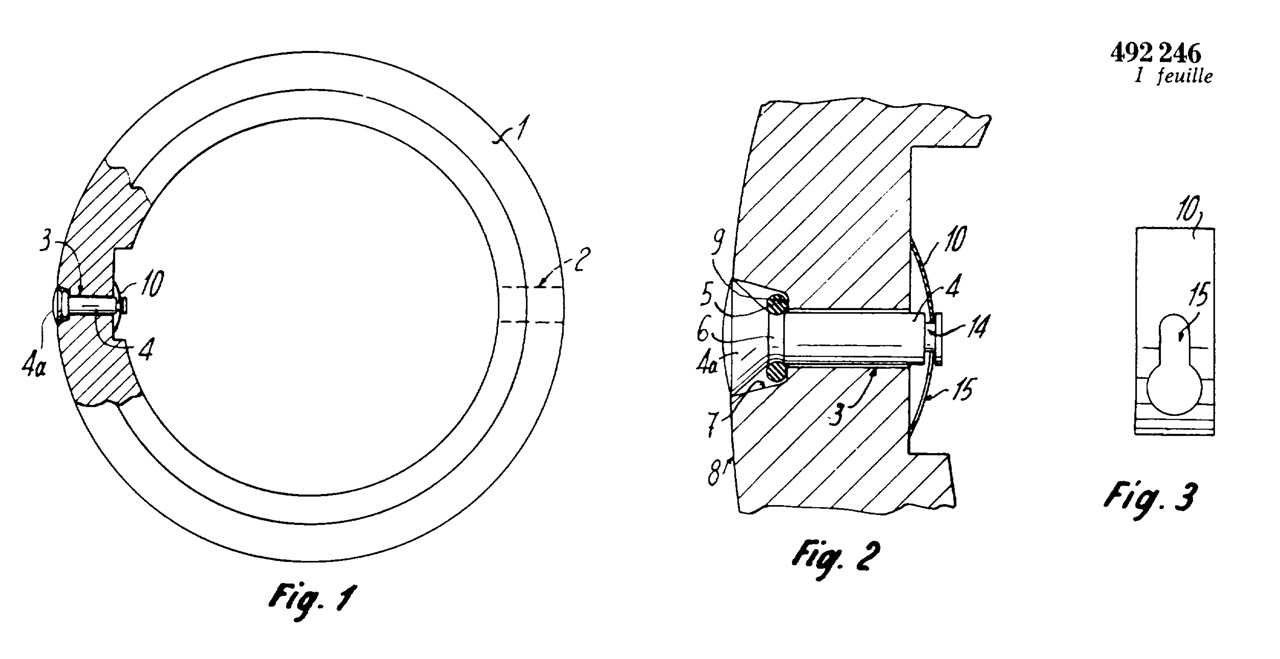
Link to Patent: Montre étanche (CH492246)
Interestingly, the very first Sea-Dweller models, the so-called Single Red Sea-Dweller (aka SRSD) with a depth rating of 1650 ft/500 m, are marked II.67 on the inside of the caseback – suggesting they were produced in the second quarter of 1967. That would be between April and June 1967, at least four months before the patent application was filed.
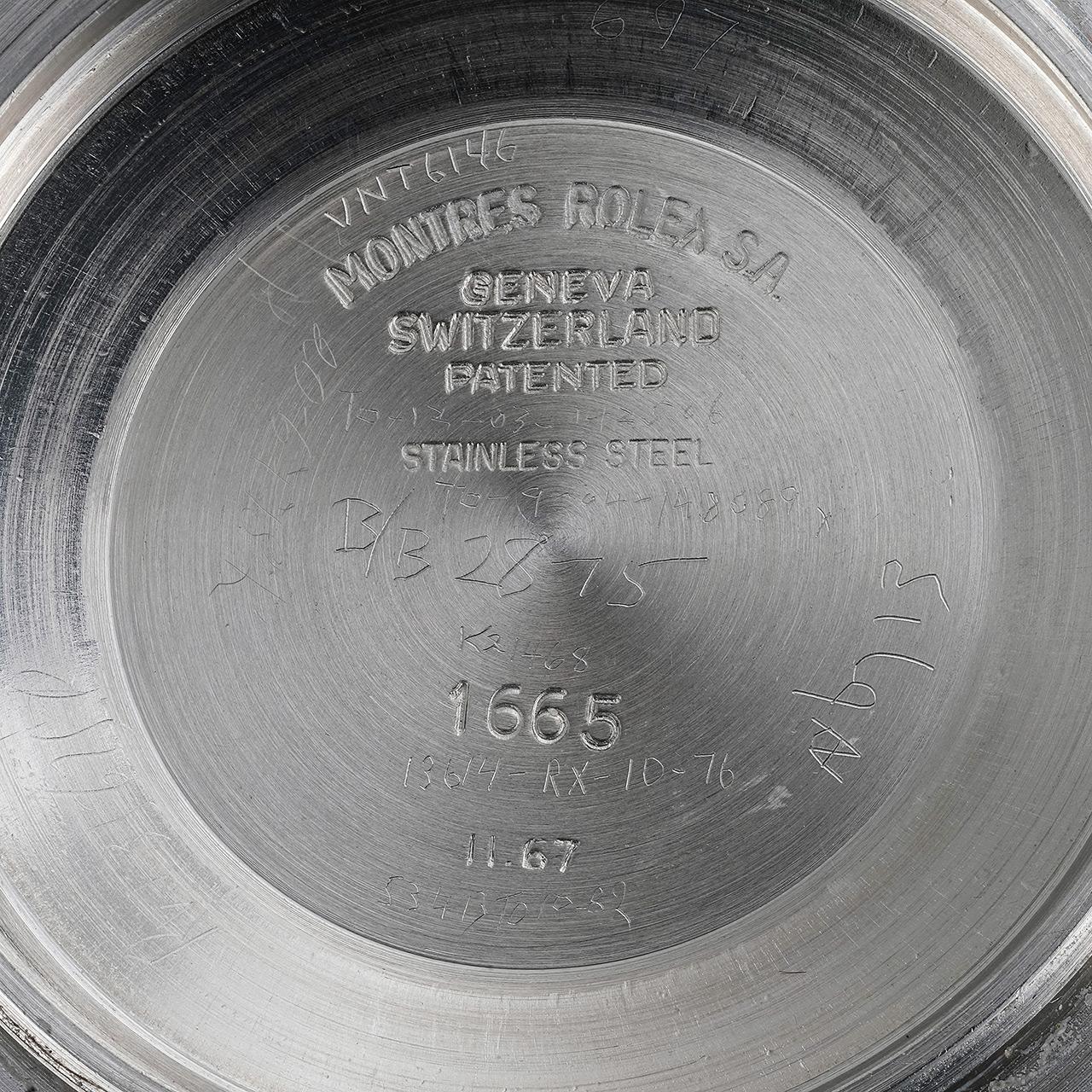
This fact leads me to believe the initial Sea-Dweller was conceived as some sort of Uber Submariner with a considerably increased water resistance of 1650 ft/500 m as opposed to 660 ft/200 m of the normal Submariner (Ref. 5512/5513). When these watches were made, Rolex was most certainly not yet aware of the issues posed by helium entering the watches and accordingly the majority of these watches do not have a valve. More on this later.
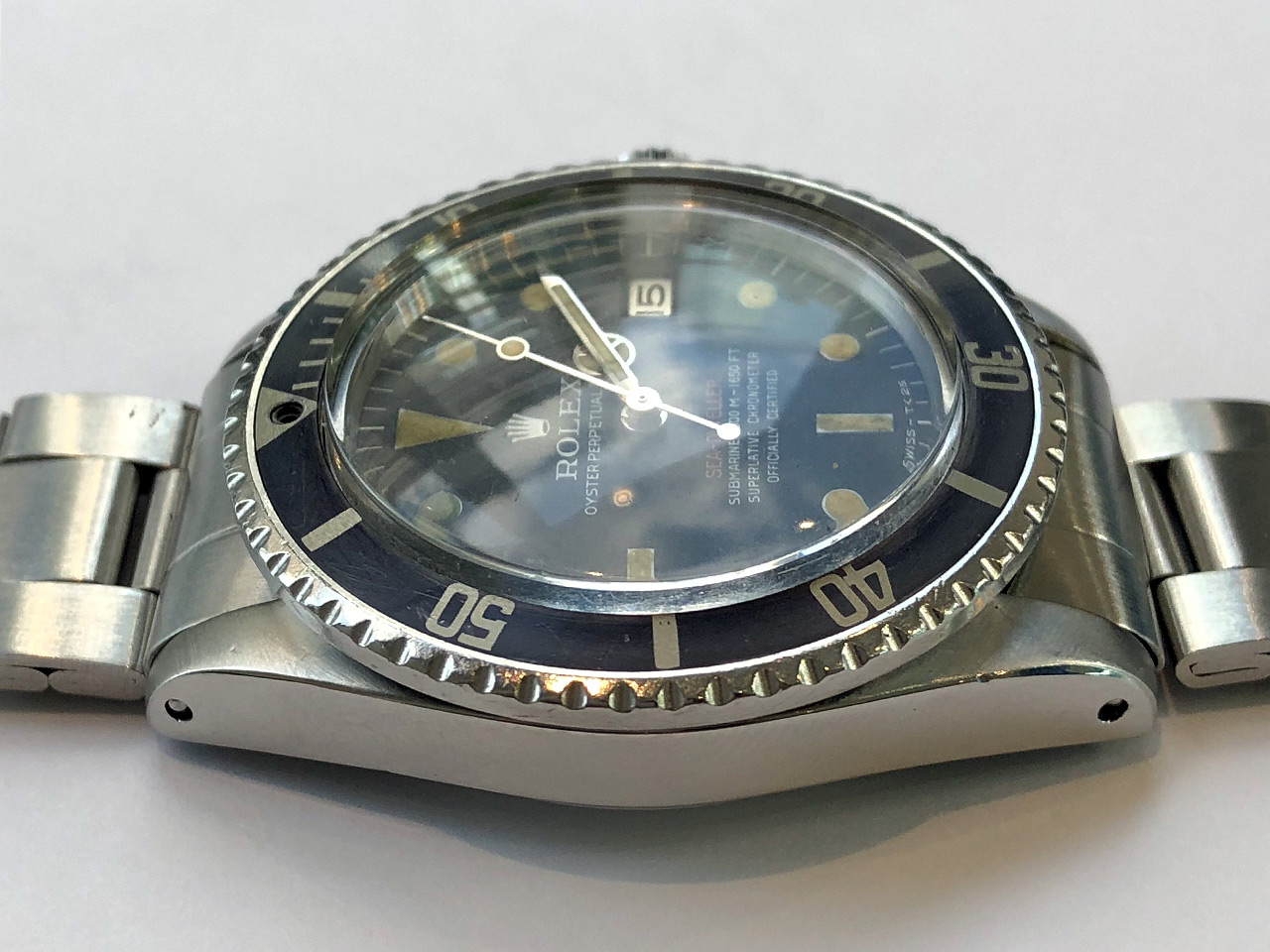
The name Sea-Dweller was a direct reference to the world famous US Navy SEALAB divers known as Aquanauts. While the Astronauts were responsible for exploring the Outer Space, the Aquanauts submerged themselves into the so-called Inner Space to try and conquer the continental shelfs.

A new method known as saturation diving developed by US Navy physician Dr. George F. Bond in the late 1950s enabled Aquanauts to spend days or even weeks in a row living in underwater habitats at the bottom of the ocean. The Aquanauts became free agents of the sea, literally dwelling in their new environment.
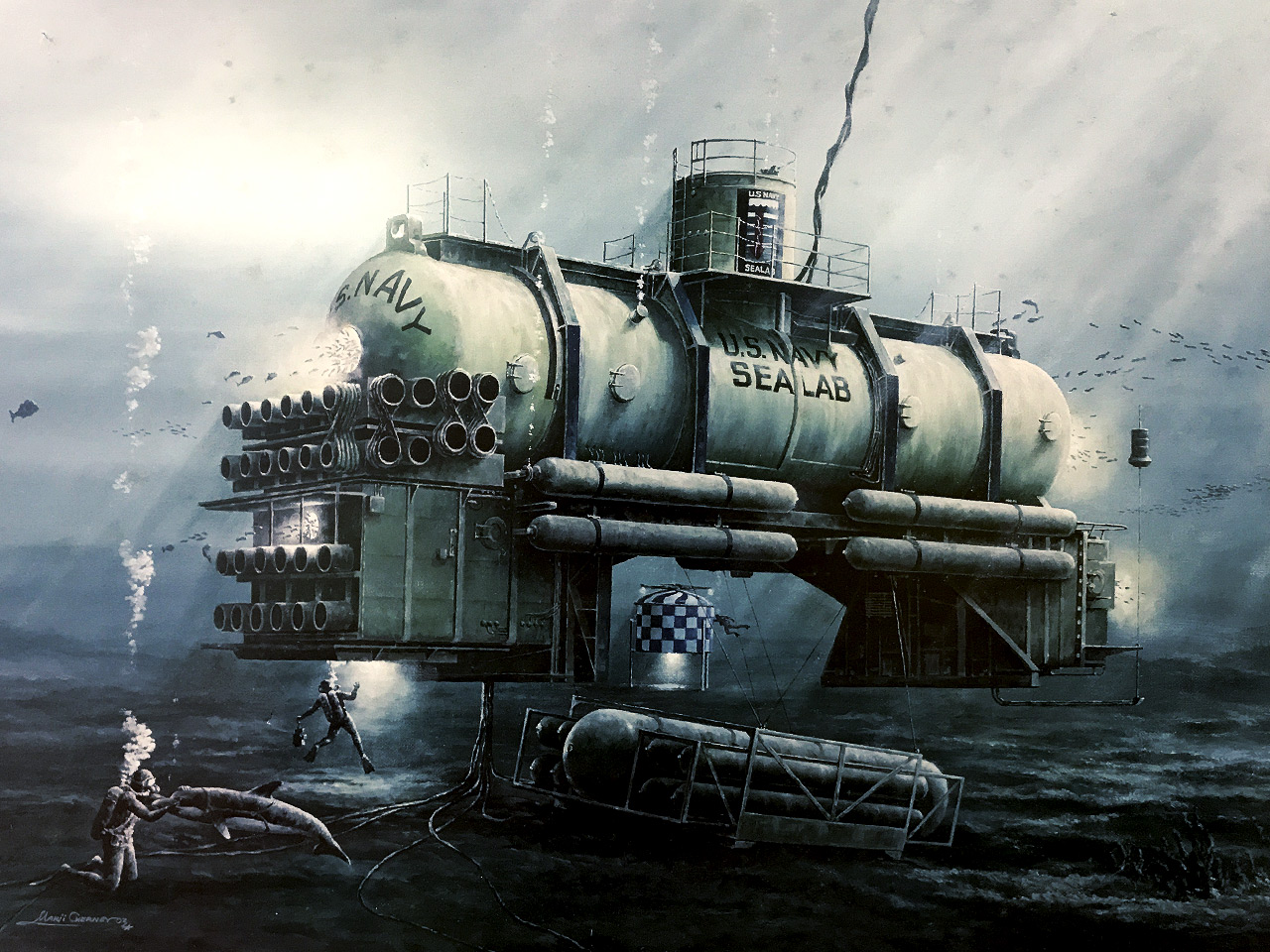
The following quote is from a SEALAB 2 documentary from 1966.
“…to go further, men have begun to go down to the sea, not to fossick, not to play within it but to dwell, to live for a while…”
To make a prolonged stay at the bottom possible, the Aquanauts were required to breath a special breathing gas composed of 95% helium (He) and 5% oxygen (O2) until their body tissues became completely saturated with the gas. Saturated divers could stay at depth indefinitely and decompression was only required when they returned to the surface after finishing their work.
Prior to Dr. Bond’s saturation theory, depth and duration of deep dives was extremely limited by the anesthetizing and intoxicating effects of regular air in pressurized environments (e.g. nitrogen narcosis and oxygen toxicity). A dive to 195 ft/60 m of depth was only possible for around 15 minutes and required lenghty decompression after each dive which made working at depth almost impossible.
With saturation diving, going underwater was no longer just a matter of minutes, it could last for days or even weeks provided the divers had a dry underwater habitat where they could rest. With this in mind, Rolex equipped the Sea-Dweller with a date complication to help Aquanauts keep track of life on the surface. To emphasize the new date function, the Single Red Sea-Dweller dial had the word Date printed in larger letters.

.
With every new saturation diving experiment – whether in a hyperbaric chamber or in the open sea – the Aquanauts went deeper and deeper.
In mid 1966, following the success of SEALAB 2, the US Navy greenlighted SEALAB 3. The plan was to lower an updated version of the SEALAB 2 habitat to a depth of 450 ft/137 m. The Aquanauts living in the habitat would attempt to go down to 600 ft/183 m.

At 600 ft/183 m, a contemporary Rolex Submariner 5512/5513 with a depth rating of 660 ft/200 m as used by the majority of Aquanauts during SEALAB 2 (205 ft/62 m) was already near its limits.
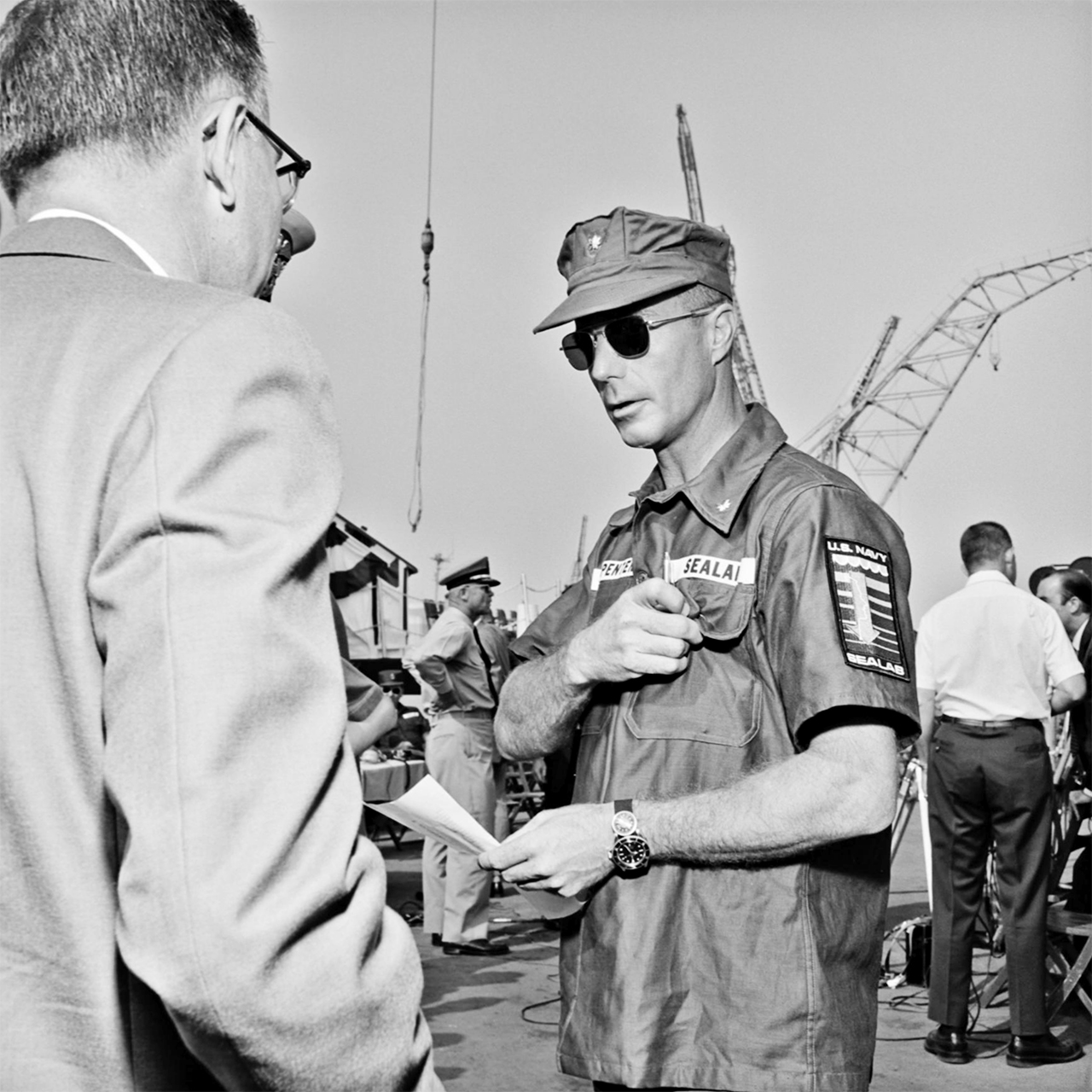
.
The picture below shows one of around 25 pieces of the Rolex Submariner Ref. 5512 delivered to the US Navy for SEALAB 2.
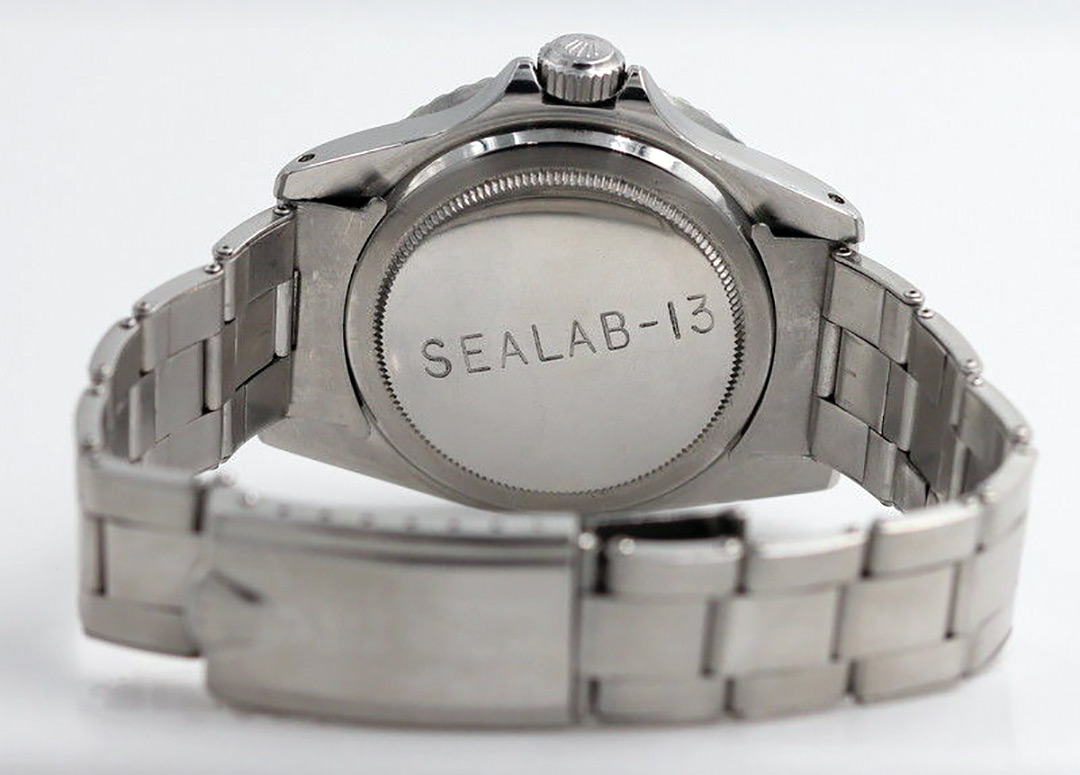
Read more: SEALAB 2 – Rolex Submariners
Excited about the immense possibilities of saturation diving, Rolex developed Ref. 1665, an Uber Submariner with a considerably increased depth rating of 1650 ft/500 m.
Between April and June 1967, Rolex produced a first batch of around 40 Single Red Sea-Dweller prototypes specifically made for the upcoming US Navy SEALAB 3 experiment scheduled for October 1967. Five eight-man teams were scheduled to live in the habitat for a total of 60 days. All of these watches are marked with the American Rolex import code ROW (balance bridge) as the they were imported to the US.

Aware of the marketing potential that equipping the SEALAB Aquanauts with the new Uber Submariner would have, Rolex launched the serial production of this model (1.7 million). Thousands of cases were produced including casebacks stamped IV.67 (fourth quarter 1967). This move turned out to be premature.
Exploding Watches
Around the same time, US Navy Aquanaut and pioneer in saturation diving – Bob Barth – met a diver named T. Walker Lloyd at a dive trade show in New York. T. Walker Lloyd was an archeological diver mostly diving on compressed air. He was preparing for an archaeological excavation off the coast of Bodrum in Turkey led by underwater archeologist Dr. George Bass.
During their conversation about saturation diving, Bob mentioned a fascinating phenomenon T. Walker Lloyd had never heard of. When saturation divers went through decompression after weeks at depth, their watches literally exploded. The reason being that helium molecules were so tiny, they were able to penetrate the watch cases during prolonged exposure.

Once saturation divers started the process of decompression, the helium inside the watches could not escape fast enough and became trapped. The internal pressure – now much higher than the steadily decreasing pressure in the decompression chamber – caused the weakest part of the watches, the crystals, to pop off. The divers learned quickly how to deal with this issue. Before decompression, they simply unscrewed their crowns. If they forgot, however, their watches were damaged. An automatic solution was needed and Bob Barth had already figured out what to do. His idea was simple yet brilliant: To install a tiny one-way valve to allow accumulated helium gas to exit the watch in a controlled fashion.

After this encounter, T. Walker Lloyd seized the moment and shared the acquired knowledge with Rolex. This is when Rolex became aware that their latest Sea-Dweller model was not up to the task. Serial production of the watch had already begun (1.7 million) and this new information forced Rolex back to the drawing board. André Heiniger, the director of Rolex at the time and a diver himself, was fascinated by Lloyd’s knowledge on saturation diving, so much so, he offered him a job as Oceanographic Consultant for Rolex in order to keep in touch with the latest developments.
T. Walker Lloyd’s role in the developement of the valve was mentioned in one of Rolex’s oldest Sea-Dweller advertisements.

“The Rolex Sea Dweller, however, is fitted with a patented gas escape valve. As the Oceanographic Consultant for Rolex, T. Walker Lloyd has kept in touch with the development of this unique feature since its conception.”
.
Around the same time, the Swiss watch company Omega started working with the emerging French diving company Comex (Compagnie Martime d’Expertises) to develop a new generation of professional diving watches for the specific purpose of saturation diving. Omega knew of the helium issues and their approach was to create a watch so tight and solid that helium could not enter the case.
Nobody was pushing the envelope like Comex. In 1965, they developed their first bell-chamber system named Idéfix with a diving bell locked onto a deck decompression chamber to which the divers transferred when the bell was brought to the surface.
With saturation diving system like this in place, Comex established a record-breaking dive to a depth of 525 ft/160 m in 1966 and became famous overnight. This accomplishment resulted in a lucrative contract for a pipeline repair job off the coast of Greece (345 ft/105 m), followed by jobs from major Oil companies which ultimately led to Comex’s meteoric rise to industrial success.
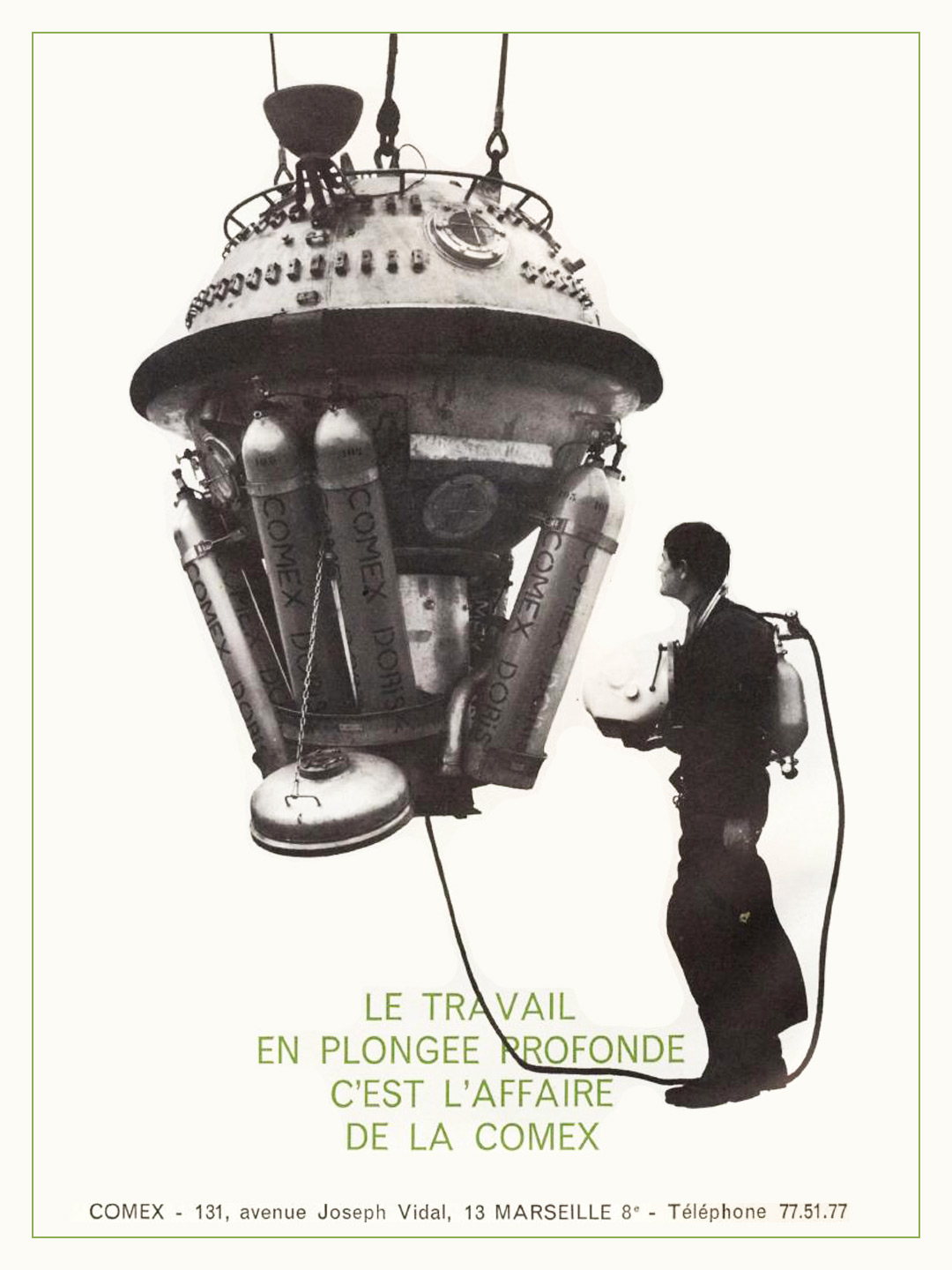
Rolex had to move fast as they had lost the prestigious race to Outer Space against Omega’s formidable Speedmaster Professional and were under massive pressure to win this new race to conquer the so-called Inner Space.
André Zibach, a former Patek Philippe watchmaker working for Rolex since the mid 1960s, designed the actual Gas Escape Valve. The goal was clearly to create a simple solution that could also be easily retrofitted to already produced batches. The corresponding patent was quickly filed on November 6, 1967.
The valve idea saved Rolex from having to invest in developing a completely new watch for saturation diving. The Oyster case remained untouched in its concept. As mentioned earlier, Omega’s approach was to prevent helium from entering the watch in the first place.
The funtional principle of the helium release valve is quite simple. Since it is a one-way valve, no water can enter the case. External pressure pushes the valve stem against the rubber gasket creating an impenetrable seal. Accumulated helium on the inside of the case can escape in a controlled fashion as soon as a certain inside pressure is reached. In saturation diving, this process occurs always in dry decompression chambers.

The valve worked well in theory but how would it perform under real life conditions in a helium atmosphere? Rolex had no infrastructure to test the device and SEALAB 3 was postponed to late 1968 as it had no top priority in the Navy due to the Vietnam War and other defense requirements.
Comex Physalie
On March 5, 1968, Comex suprised the world with a spectacular record dive named Physalie in which Comex founder Henri Germain Delauze and American physiologist and leading hyperbaric researcher Prof. Dr. Ralph Werner Brauer descended to the equivalent of 1100 ft/335 m in a pressure chamber at the Comex Hyperbaric Center in Marseille, France.
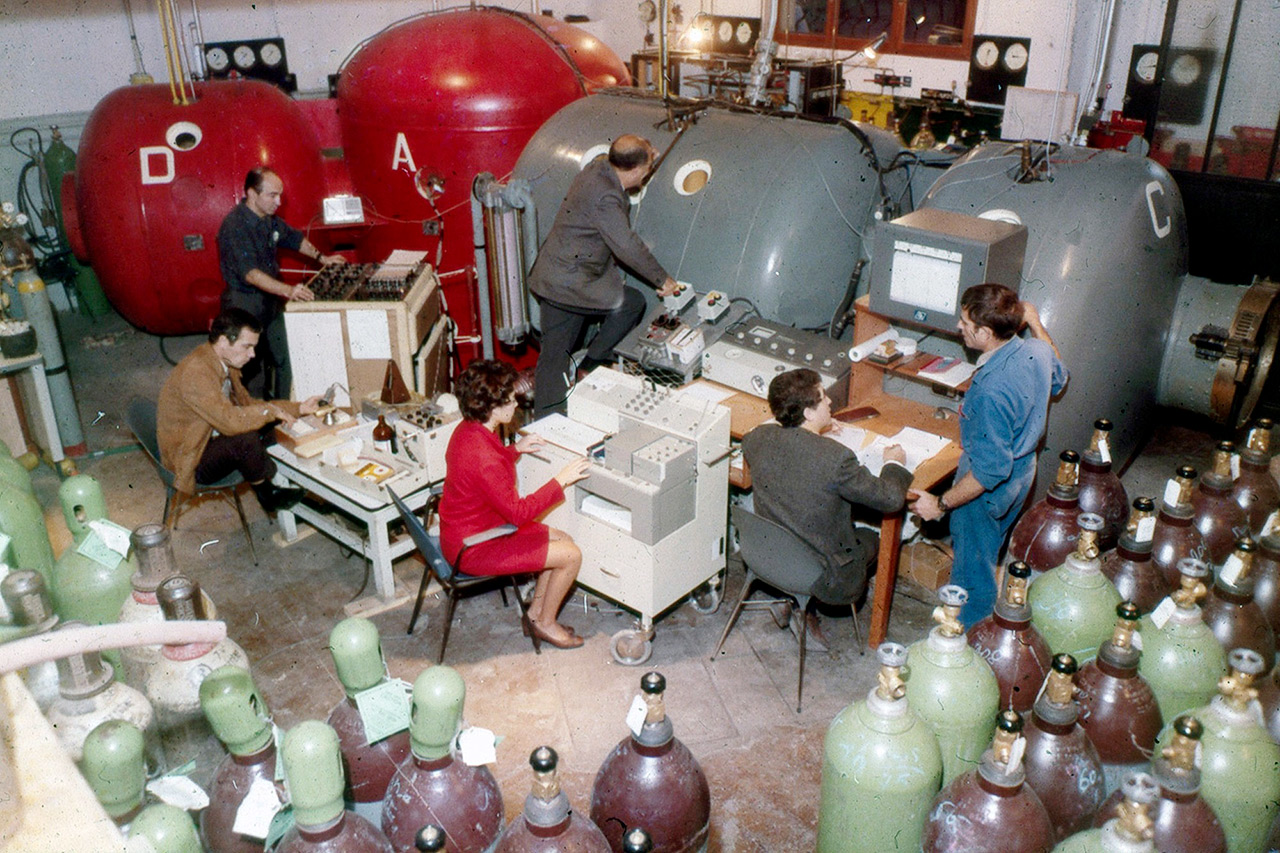
With the news of the record dive, Comex and Dr. Brauer announced an even more radical and daring experiment in the open sea with the awe-inspiring name Hydra 1, the first human trial to involve highly explosive hydrogen gas.
The primary goal of Physalie 1 was to trigger a condition known as helium tremors which was first discovered in 1965 by Dr. Peter B. Bennett during rapid compression experiments for deep submarine escape methods conducted by the Royal Navy. Researchers assumed man had reached a physiological barrier that would make it impossible to dive deeper than 1000 ft/300 m.
In 1966, Dr. Brauer started working on solving this problem. He figured that thanks to its unique characteristics, hydrogen could replace helium at pressures beyong the helium barrier. A series of animal tests proved the feasibility of his theories.
To be able to experience and accurately describe the helium tremors himself, Dr. Brauer volunteered to climb into the hyperbaric chamber and be his own guinea pig. Asked what his motivations were, Brauer replied:
“As an investigator I can see more by climbing into a given situation than someone who has not worried about why these things work. My ears are tuned more keenly to little changes and I can interpret the fact that my little finger tingles where a much more experienced diver would long ago have learned that one ignores things like that. I don’t. I listen to that little finger because this may mean I have an interesting change in blood circulation that I can use. Or I can interpret other effects of nitrogen narcosis or inert narcosis. Not only do we get absolute data, but by going to get it we see things we haven’t seen before and that allows us to make sense of the situation.”
As hoped, Brauer experienced the tremors during Physalie 1 but they were accompanied by a number of other symptoms like somnolence and decreased mental performance. After a few minutes at depth, the descent was reversed and after three days of decompression, he and Henri Delauze returned safely to normal surface pressure. Thanks to the gathered data, it became apparent the problems were not caused by pressurized helium but rather by the extreme pressure itself. Dr. Brauer was the first scientist to describe the disorder in its entirety and coined the phrase High-Pressure Nervous Syndrome.
The picture below shows Henri Delauze and Dr. Ralph W. Brauer (right) during the experiment inside the hyperbaric chamber. The bandages on Brauer’s head and leg were needed to secure a number of implanted electrodes that measured his brain activity, etc. during the experiment.

As mentioned earlier, Comex was cooperating with Omega at the time and as a matter of fact, the above picture shows Brauer wearing a massive Omega Seamaster 300 prototype.
Dr. Brauer passed unexpectedly in fall 2000 and having no family, the University of North Carolina Wilmington where he was a long tenured professor inherited his entire estate. This consisted of thousands of papers, science books and a multi-faceted artifact collection contaning numerous fascinating items.
Among these items was a super rare Rolex Single Red Sea-Dweller with Gas Escape Valve made in early/mid 1968.

According to Brauer’s assistant, the Single Red Sea-Dweller was found hidden under Brauer’s mattress, together with cash and a handgun. Incredible as this may sound, Dr. Brauer was a real life Indiana Jones with ties to the secret services and a true explorer always chasing the ultimate adventure.
Prof. Dr. Ralph Werner Brauer
In his public life, Dr. Brauer was a professor for physiology at Duke University and director of the Wrightsville Marine Biomedical Laboratory of the University of North Carolina Wilmington.
The picture below taken during the workshop Techniques for diving deeper than 1,500 feet of the Undersea & Hyperbaric Medical Society (UHMS) in 1980 shows Dr. Ralph Brauer (front, 3rd from right) among other famous hyperbaric researchers like Peter B. Bennett (front, 5th from left) and Medical Director of Comex Dr. Xavier Fructus (behind Brauer).
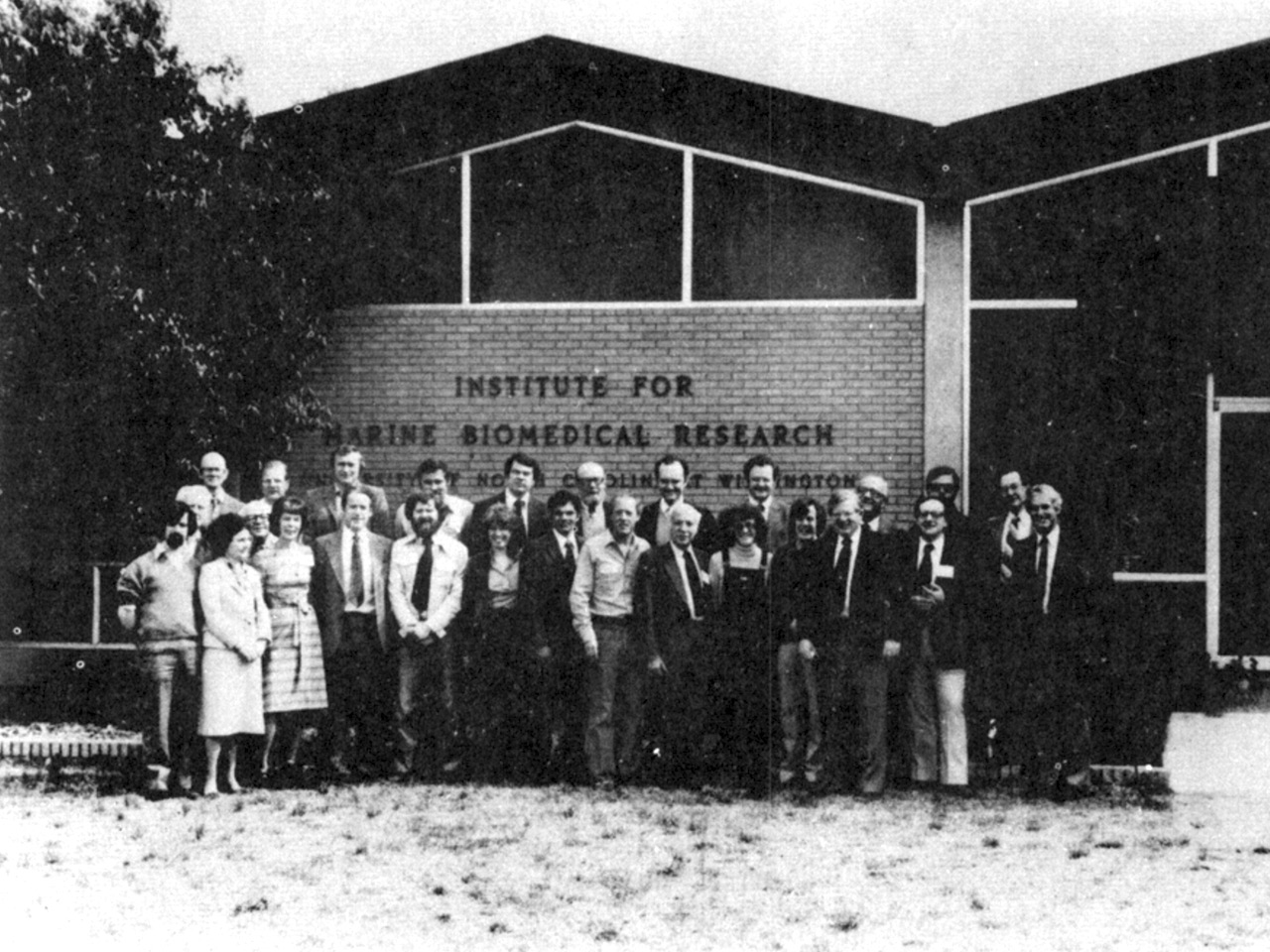
Dr. Ralph W. Brauer had an amazing resume. Born in Berlin in 1921, he and his widowed father Dr. Frederick Brauer fled Nazi Germany in 1937. When war broke out in Europe, Ralph’s father obtained a presidential exemption from classification as enemy alien. In 1943, both became American citizens. At age 21, Ralph Brauer made his doctorate in biochemistry. He was the youngest recipient of a Ph.D. from the University of Rochester.
After years of teaching at Harvard Medical School, Brauer started working for the US government as Head of the Pharmalogical Branch of the US Naval Radiological Defense Laboratory in San Francisco, the US military’s largest facility for applied nuclear research.
As a member of the Atomic Energy Commission, Brauer embarked in 1964 on an expedition to the high Andes of southern Peru to study cosmic radiation effects on indigenous people genetically related to the Inkas.
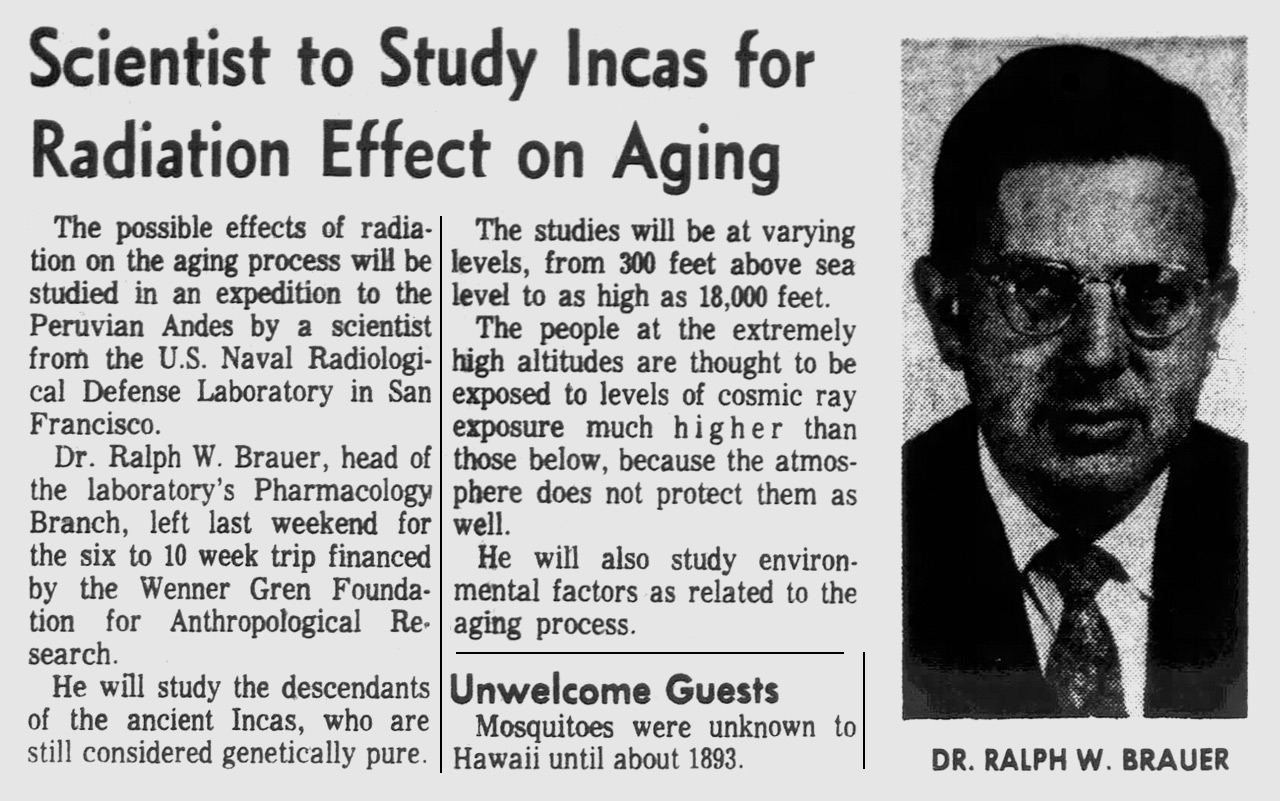
Brauer spoke six languages, plus some Peruvian Indian dialects. He was in frequent contact with SEALAB and Jacques Cousteau’s team, especially their medical director Dr. Xavier Fructus who in 1965 started working for Comex. According to a 1971 newspaper report, Brauer was the only American ever invited to participate in the Soviet Union’s deep-sea projects.

Brauer was travelling frequently. It was a running joke at the university how each time Brauer travelled, some mayhem or disaster would occur at his destination. For example, during a 1972 research expedition to Lake Managua in Nicaragua, Brauer and two of his students went missing after a devastating earthquake that killed more than 5,000 people and left 90% of Managua destroyed.

One of Brauer’s assistants implied the doctor had ties to the CIA. As a founding member of the Undersea & Hyperbaric Medical Society (UHMS) established in April 1967, Dr. Brauer was involved in top-secret projects for the US Government to conquer the so-called Inner Space ahead of the Soviets. The UHMS consisted of the crème de la crème of American underwater researchers such as Dr. Christian J. Lambertsen, Capt. George F. Bond, Capt. Walter F. Mazzone and Dr. Edward L. Beckman. Information on Dr. Brauer is almost impossible to find. He was very low-profile, probably for good reasons.
In 1978, Dr. Brauer and three of his collegues were allowed to the USSR – in the midst of the cold war – to do research on Lake Baikal, the world’s deepest and most ancient lake located in southern Siberia. During this enterprise, Brauer was allowed to use explosives and even radioactive materials for his research. According to one of his assistants, Brauer was asked by the US Government to try and extract valuable information from the Soviet officials looking after them. All this while, Brauer was secretly taking pictures with a micro camera.
After this short glimpse at the man behind the watch, it is time to take a closer look at the timepiece itself.
Rolex Single Red Sea-Dweller, Ref. 1665, 1820177
With 1820177, Brauer’s watch has an absolutely unique case number which was just confirmed by Rolex Geneva as pertaining to a Ref. 1665 manufactured in 1968. The case number suggests a production date in early/mid 1968 and appears to be more or less random. The caseback is stamped IV.67.
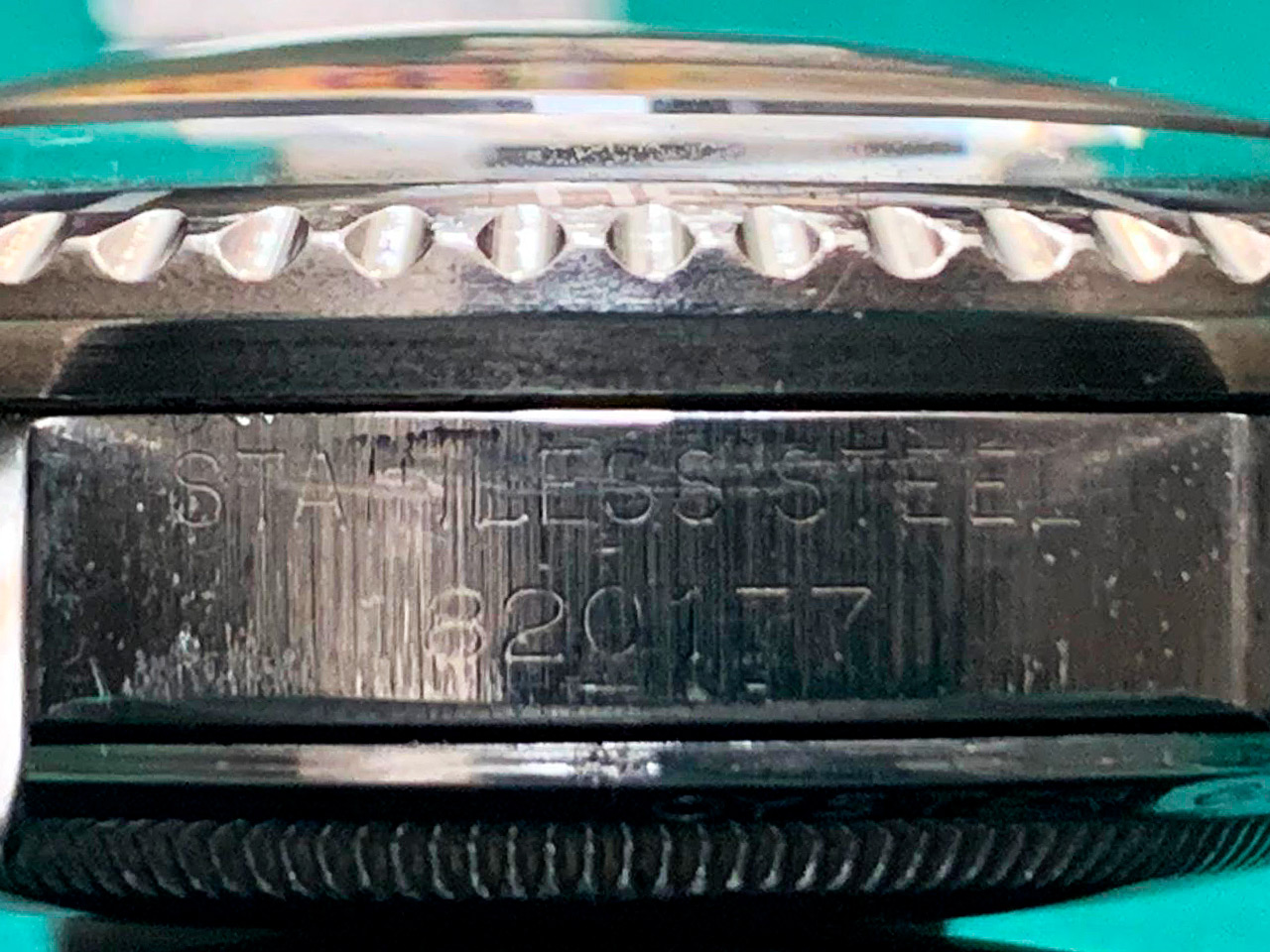
Apart from Brauer’s watch, there are no other known Sea-Dwellers in the 1.8 million range. But the uniqueness of this watch does not end here.
To properly assess Brauer’s watch it is essential to understand the production timeline. As mentioned earlier, the chronology between 1967 and 1971 is not very clear. A good way to shed light on this is to take the movement serial numbers into consideration. Movement numbers have always been an important part of my databases. As with all archives – the more data available – the clearer the picture.
Rolex collectors have been indoctrinated into thinking that movements are of no or little importance but fact is the numbers are crucial to determine whether a watch is completely original or not. Since everything was done in batches, every case batch was married with a corresponding movement batch. The term Matching Numbers used in vintage car collecting to establish whether chassis and engine were born together, can also be applied to vintage Rolex watches.
The earliest Single Red Sea-Dwellers from the 1.6 million range made between April and June 1967 (II.67) have movement serial numbers ranging between D60,000 and D75,000. These watches were imported to the United States of America as indicated by the US import code ROW found on the balance bridges of their movements.

Caliber 1575 (1570 with date complication) was an adjusted movement and therefore subject to a special import tax. Movements that were marked unadjusted were tax-free. The US introduced these codes around 1934 to protect the American watch industry.
Sea-Dwellers with 1.7 million case numbers have movement serial numbers that average between D800,000 and D850,000. See the massive leap from 1.6 million to 1.7 million? There are of course exceptions to this rule. Most of them are later calibers made after Rolex reached 999,999 and started from zero again. Apart from movement serial numbers, there are other details that help determine when calibers were made.
An interessting observation is that none of the known 1.7 million Sea-Dwellers have movements with ROW import codes. The US discontinued these codes in 1969, so logically, if the 1.7 million Sea-Dwellers were assembled in 1967 as often claimed, the watches imported to the US should bear a ROW import code.
In my opinion, the movement numbers of 1.7 million Sea-Dwellers are a clear indication that these watches were assembled in 1971, probably in the same breath as 2.6 million Sea-Dwellers that feature similar numbers. This assessment is further supported by the fact that most 1.7 million Sea-Dwellers have Double Red Mk 2 dials.
2.1 million Patent Pending Sea-Dwellers made in 1969 have movement numbers ranging from D350,000 to D400,000. 2.2 million Patent Pending Sea-Dwellers have movement serial numbers around D550,000. Both batches have lower movement numbers than the 1.7 million Sea-Dwellers.
Here is a list of average movement numbers found on Sea-Dwellers made between 1967 and 1971:
1.6 million: D60,000 – D75,000
1.7 million: D800,000 – D850,000
1.8 million: D69,043
2.1 million: D350,000 – D400,000
2.2 million: D540,000 – D550,000
2.6 million: D800,000 – D850,000
See the pattern? This is why I love data. The movement numbers bring the true production timeline to light. In view of this, a logical explanation as to why 1.7 million Sea-Dwellers were assembled at a later moment in time could be that the cases were not made to feature a valve in the first place. 1.7 mil Sea-Dwellers were most certainly conceived as Uber Submariners in the same fashion as 1.6 mil Single Red Sea-Dwellers. In order to make them into real Sea-Dwellers, the valve had to be retrofitted, a task Rolex procrastinated until 1971. This topic will be covered in more detail in the second part of the The Sea-Dweller Chronicles that will be published soon.
Brauer’s watch is a one-off in this whole picture. With serial number D69043, its 1575 caliber is well within the movement serial number range of 1.6 million SRSDs. Movement and dial were probably assembled during the 1.6 mil production and kept in stock as a reserve.
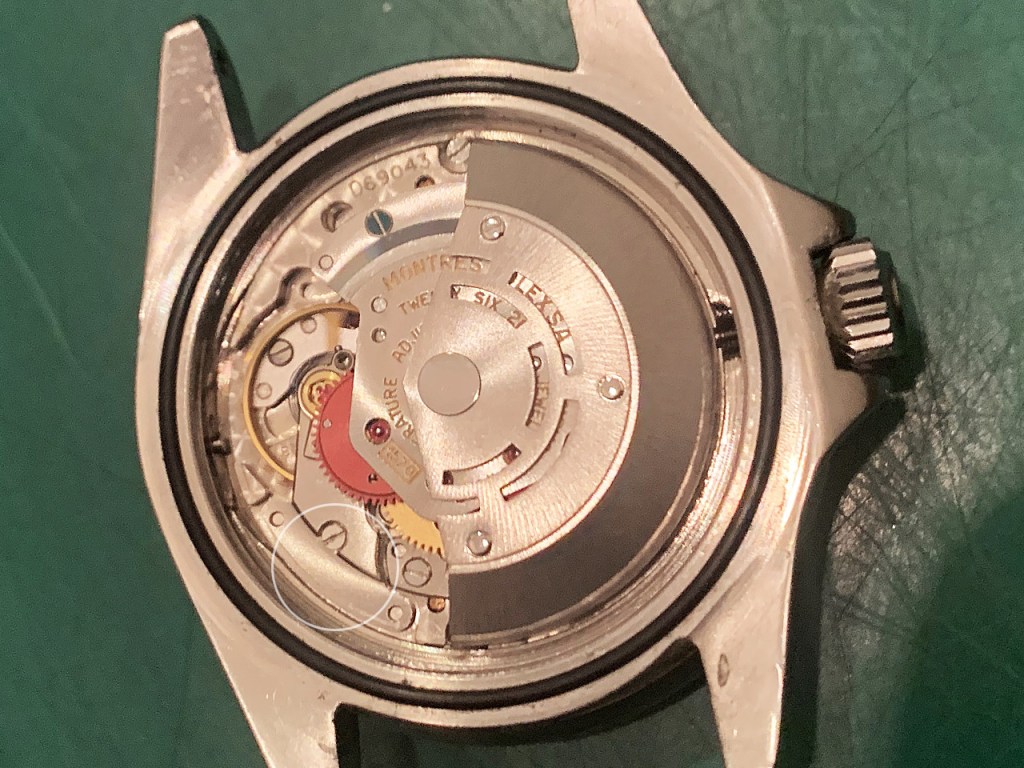
It is important to note that in 1968, Rolex had not yet developed the so-called Double Red Sea-Dweller dials (aka DRSD). These were introduced in 1969 with 2.1 and 2.2 mil Sea-Dwellers.
Brauer’s watch – unlike the earliest SRSDs – does not bear the US import code ROW which was mandatory for US import until around 1969. This is a clear indication the watch was delivered within Europe.
And this is where it gets interesting. Here is what I believe:
After news broke of the record-breaking Physalie dive and the upcoming Hydra 1 hydrogen-oxygen experiment in the open sea, Rolex realized they had been betting on the wrong horse. Not the US Navy (SEALAB) was pushing the envelope at the time but commercial companies like Comex that were not slowed down by the constant requirement of the US Navy to justify every step to higher authority. The only problem with Comex was, they were already highly involved with Omega.
Pictures of Brauer published in news articles in March 1968 showed him wearing a Rolex dive watch. Brauer was a Rolex guy and – more importantly – he was not a Comex employee. His cooperation with Comex was based on a joint venture between Comex and the Wrightsville Marine Biomedical Laboratory.
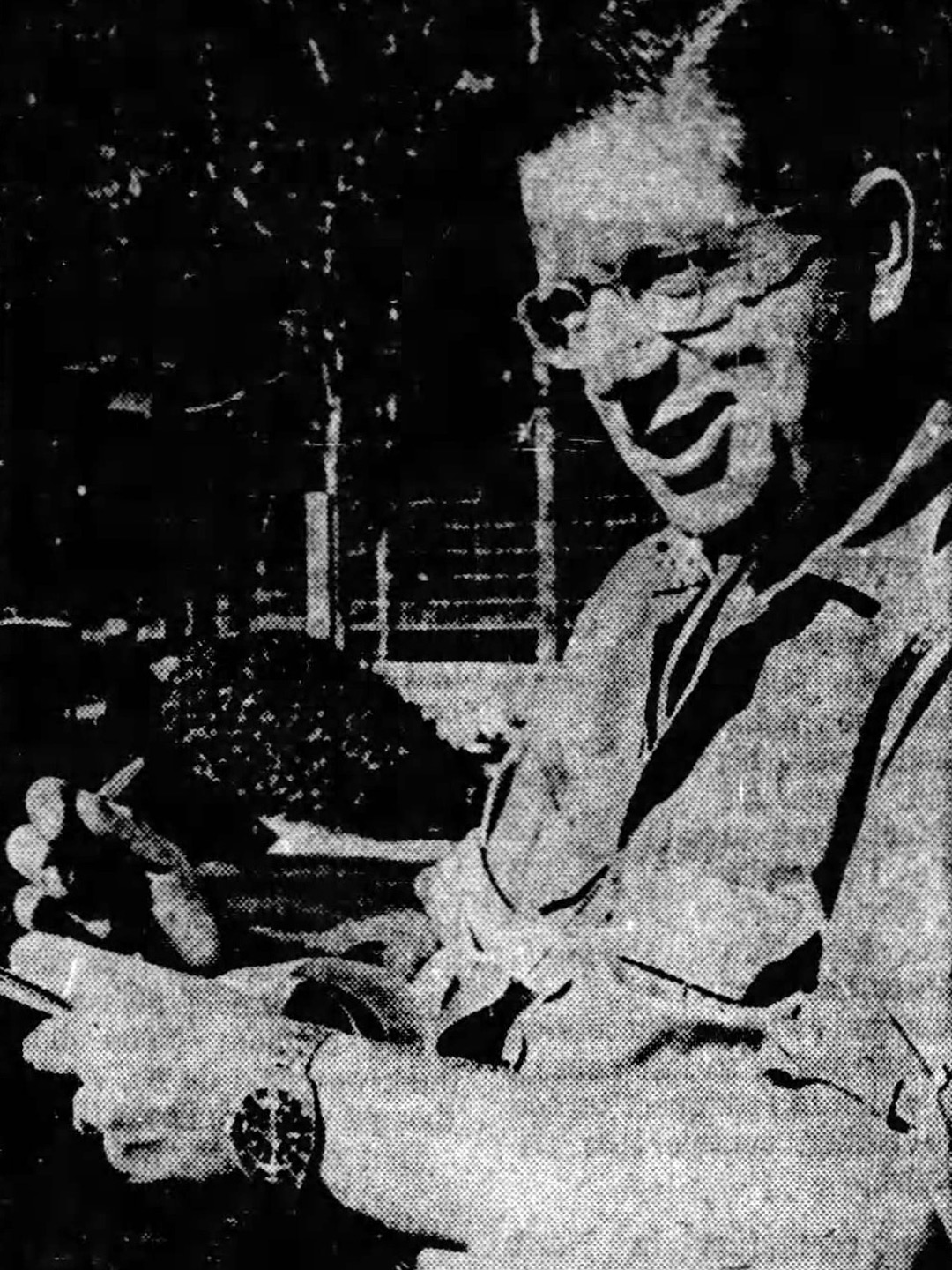
Through their contacts in the US, Rolex managed to get in touch with Dr. Brauer. During their subsequent exchange, Rolex learned in detail about Brauer’s radical idea to overcome the High-Pressure Nervous Syndrome (HPNS) by replacing helium with hydrogen. Hydrogen is not only highly explosive, its molecules are small enough to easily enter watch cases as well. Brauer expected to encounter further barriers along the way which would possibly require the use of more gases.
It became apparent the valve was not exclusive to helium but likely needed to release other gases as well. As a result, Rolex decided to give the pressure release device a more general name like Gas Escape Valve. The caseback of Brauer’s watch, as seen below, was the first Sea-Dweller to ever feature this designation. More on this later.
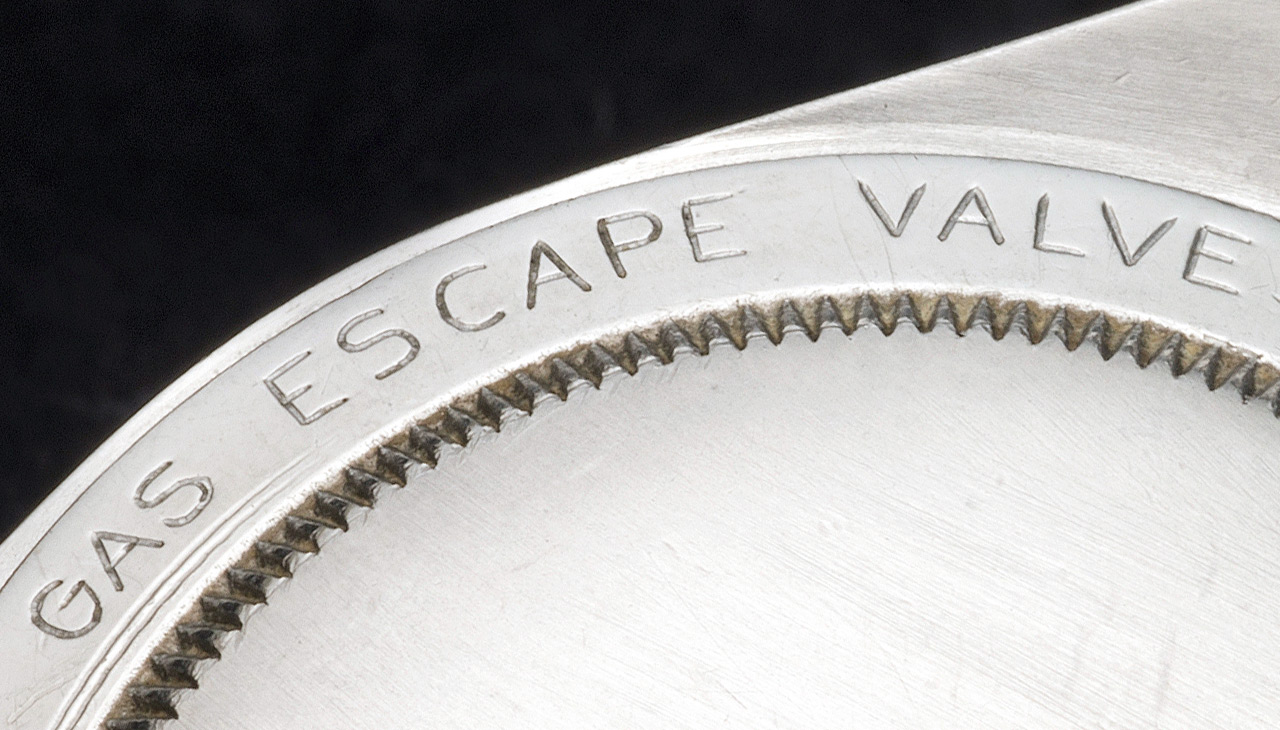
The first Physalie dive was a preliminary test for a much more radical experiment: Hydra 1, the first human trial to go beyond 1000 ft/300 m in the open sea while breathing a hydrogen-oxygen cocktail named Hydrox. As the mastermind behind the idea, Dr. Brauer volunteered to do the risky dive himself.
Comex Hydra 1
The name Hydra was carefully chosen for its similar sound to hydrogen but also in reference to the terrifying serpentine water monster from the Greek mythology that could regrow two heads for every head chopped off. Hydra 1 was a dangerous undertaking involving a highly explosive gas and nobody knew exactly what was going to happen.

Initially scheduled for May 8, 1968, Hydra 1 was postponed to June 1968, and then again to mid September 1968 due to civil disorder in France. Student protests and general strikes involving millions of workers paralized the French economy for weeks. Clashes between demonstrators and the authorities left Paris and other major French cities resembling war zones. Fearing a revolution, the French President Charles De Gaulle fled to Germany.

The following excerpt is from an article printed in the Rocky Mount Telegrame on April 21, 1968:
Deep Dive Project May Pave Way For Deeper Penetration Of Ocean
The deep-dive project, now scheduled for sometime between June 7 – 15, will take place off the coast of Marseilles, France. It has been named Hydra, ‘partly because of the critical role hydrogen will play and partly because almost as many heads will be involved as owned by the mythological monster,’ Brauer says.
Hydra 1 will be a joint venture of the Wrightsville Laboratory and Compagnie Maritime d’Expertises (Comex), a French firm that is interested in the development of deep-sea divingcraft and other diving techniques. Comex is headed by the senior scientist of the French Bathscaph Program, Dr. Henri Delauze.
Also involved in the program will be the hyperbaric oxygenation group at Duke Medical Center. Duke’s new hyperbaric chamber, capable of simulating atmospheric conditions found 1,000 feet beneath the sea, is being used for preliminary tests leading up to the deep diver off the coast of France.
Two people will accompany Brauer on the actual ocean dive: Andre Veyrune, Comex engineer and diver; and either Dr. Xavier Fructus, chief of medical research for Comex, or Fructus’ son, Dr. Pierre Fructus.
The three men will be lowered in the diving bell to a depth of 600 feet. At that point, Brauer and Veyrune will emerge from the bell and sit for a time on an attached platform.
Brauer will be heavily instrumented. Electrodes will be implanted into his scalp to provide constant monitoring of his brain waves. Gas analyzing equipment will monitor all of his exhalations.
Here Brauer will make a drastic departure from normal deep-diving routines. Until they reach 600 feet, all three divers will be breathing the conventional deep-dive mixture of helium and oxygen. But recent developments indicate that helium may have its limitations.
So Brauer will switch to a mixture of hydrogen and oxygen and the bell will be lowered deeper into the sea. He will be watched carefully by his companions. The monitoring devices will be scanned by other colleagues on the surface ship of Hydra.
If all goes well, the depths to which man can penetrate the ocean may be extended.
Download full article: Deep Dive Project May Pave Way For Deeper Penetration Of Ocean
To take full advantage of the delay, Dr. Brauer decided to stay in Marseille and conduct further experiments to study the High-Pressure Nervous Syndrome more closely. During this time, Dr. Brauer met with Rolex representatives and was presented his Rolex Single Red Sea-Dweller prototype with unique case number 1820177.
On June 11, Brauer established yet another record when he and Comex diver Renè Veyrunes were pressurized to the equivalent of 1181 ft/360 m of depth in Physalie 2. Only two weeks later on June 27, the same two men aimed for mind-blowing 1312 ft/400 m in Physalie 3 but were forced to stop at 1190 ft/365 m of depth due to alarming symptoms of the High-Pressure Nervous Syndrome.
Is it far-fetched to believe Dr. Brauer smuggled a stowaway into the hyperbaric chamber during these two dives, namely his Single Red Sea-Dweller with Gas Escape Valve? I don’t think so. The supreme irony is – officially – it was Omega that established world records during Physalie but the Rolex was right there with the Omega.
After the Physalie test dives, Brauer went back to his lab in North Carolina to conduct final tests on primates before the actual dive. Monkeys breathing hydrogen-oxygen were successfully pressurized to the equivalent of 2,100 ft/640 m of depth and brought back to surface pressure with no apparent ill effects. Everything was ready for Hydra 1.
Hydrogen gas is inexpensive compared to helium but much more difficult to handle. Remember the Hindenburg disaster from May 6, 1937? The Hindenburg was filled with hydrogen, a highly flammable, lighter-than-air gas that provided the airship’s lift.
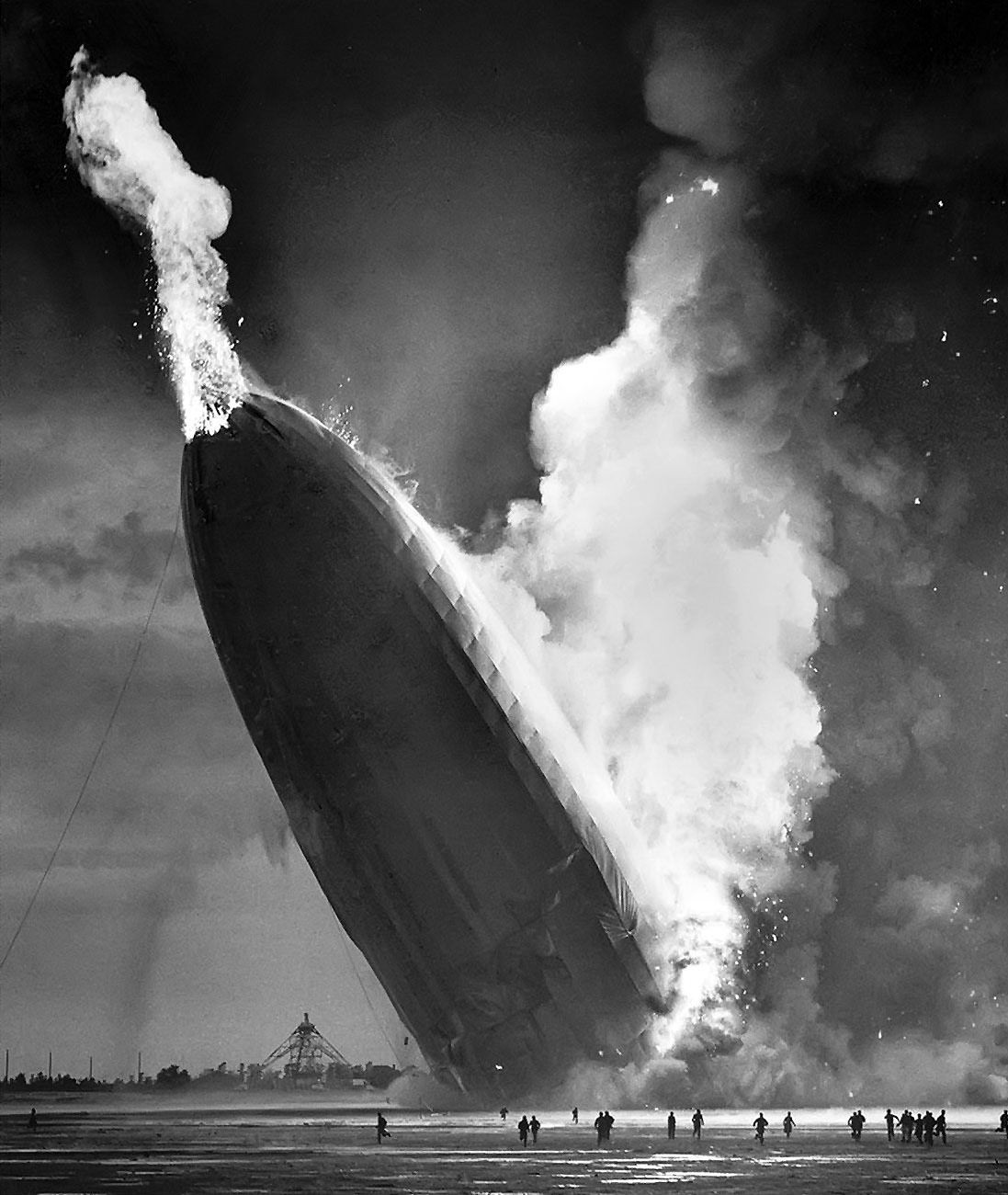
For safety reasons, Hydra 1 took place outside the diving bell where the surrounding water could provide insulation against possible leakage. The experiment was again delayed and took finally place on October 28, 1968.
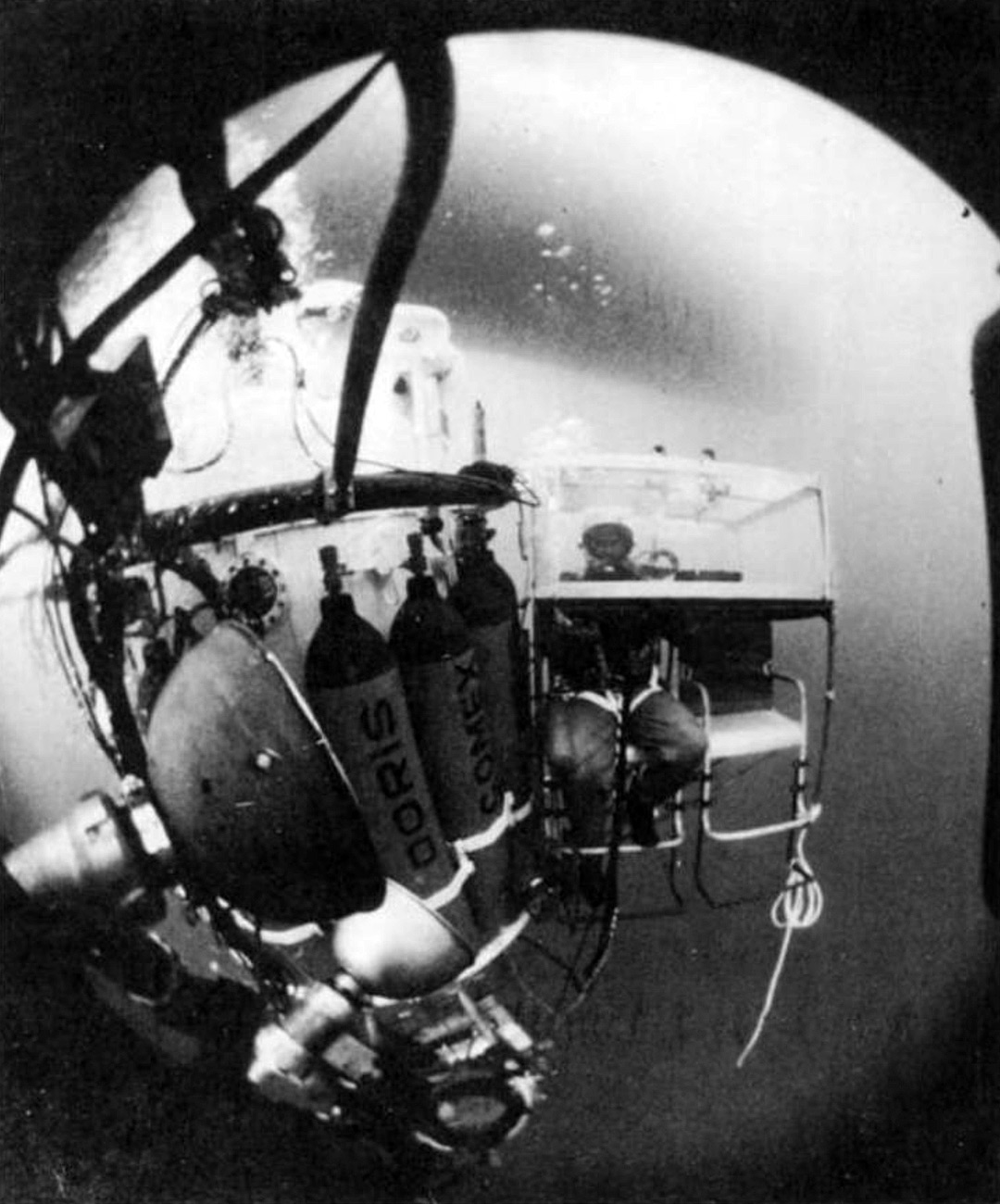
The next picture shows Dr. Ralph Brauer geared up and ready for the dive. Just before the descent, an ear problem denied Dr. Brauer the possibility to set another amazing deep dive record. He was replaced by Comex diver François Fallourd.
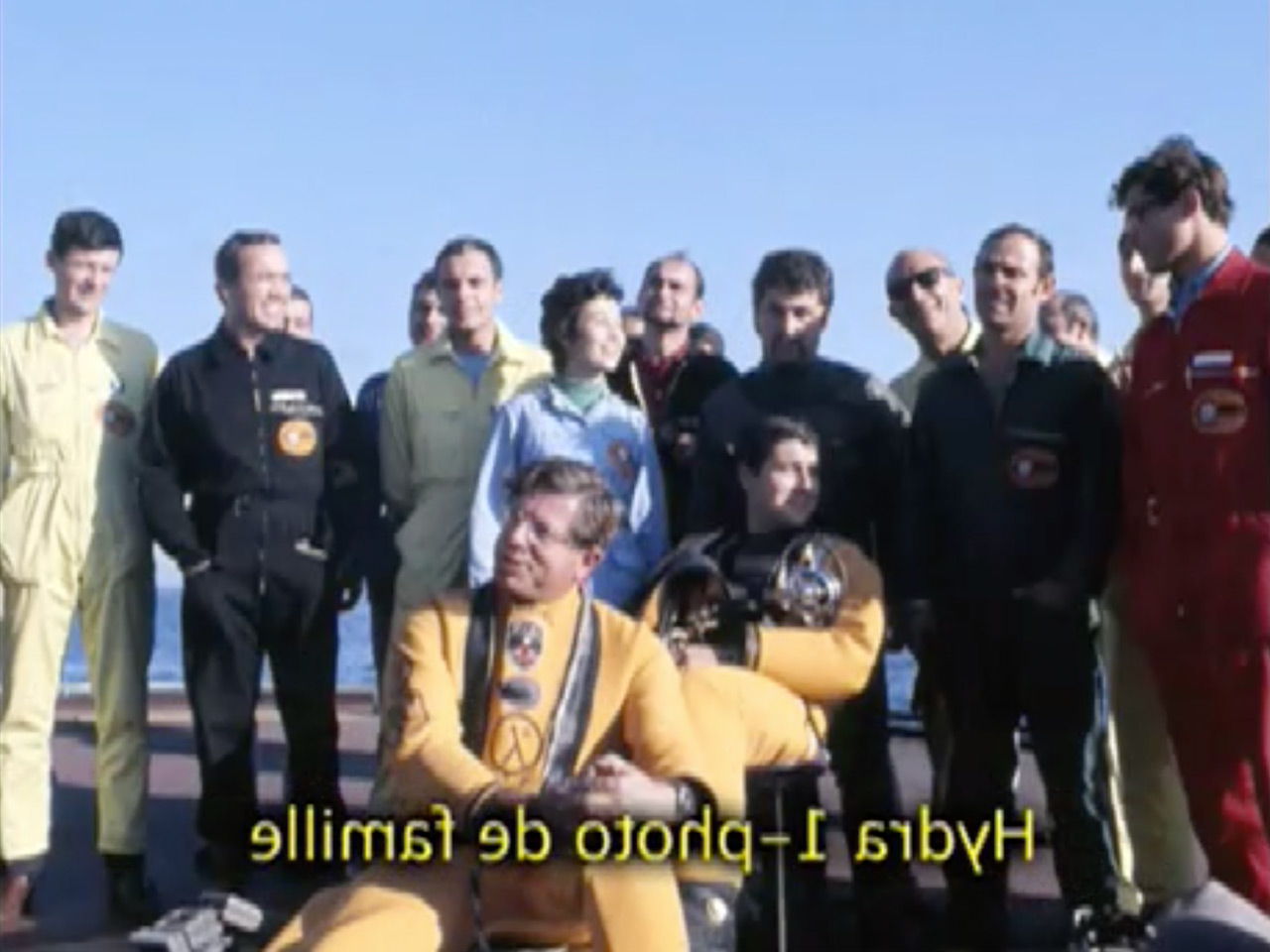
It is unknown which watch Brauer was wearing in this photo. For Hydra 1, Omega provided Comex with five special PloProf prototype watches. PloProf was short for Plongeur Professionnel = professional diver.
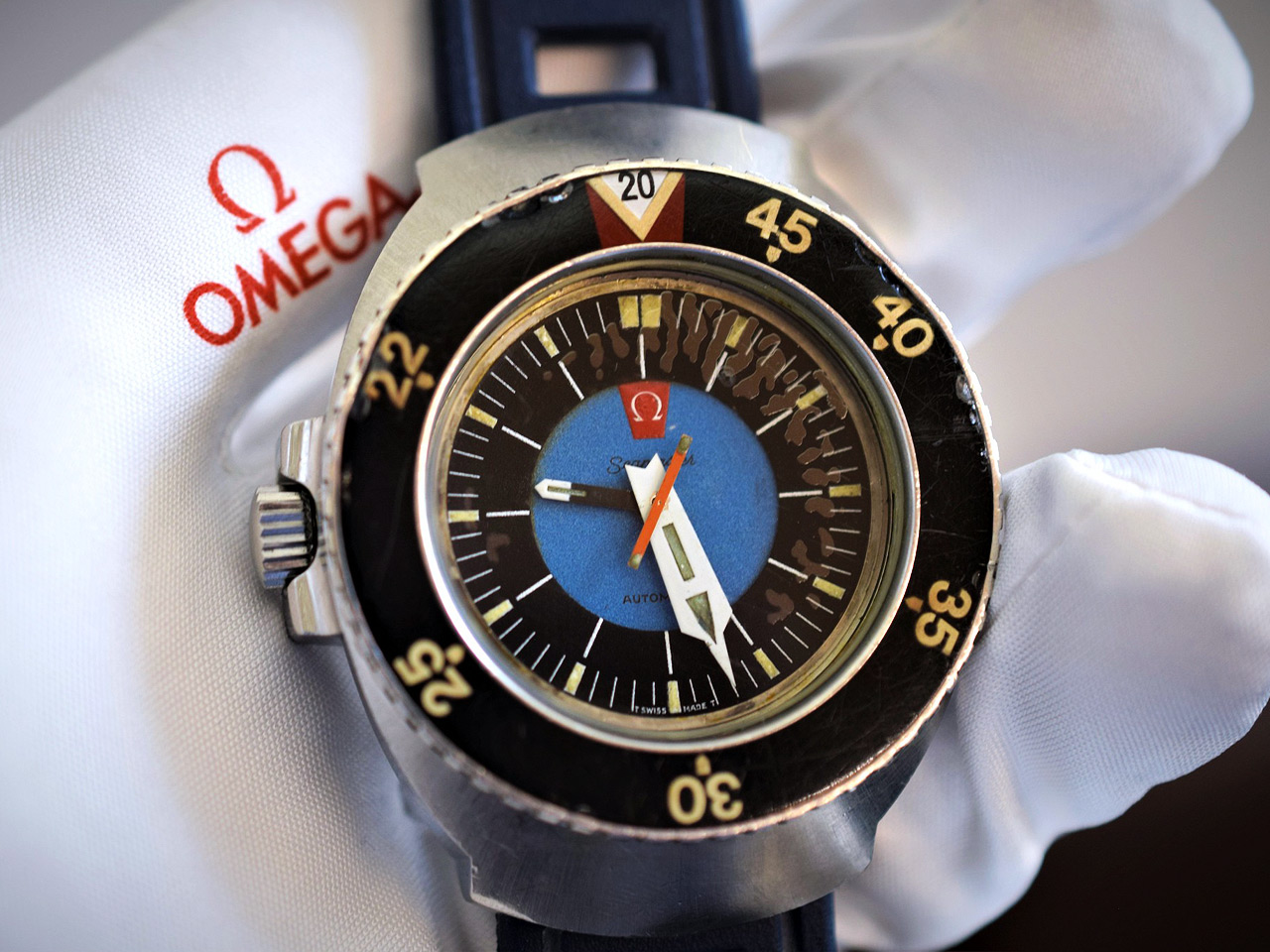
.
Omega’s plan to use Hydra 1 for a big press release to promote their diving watches fell flat as the goal to break the 1000 ft/300 m depth barrier in the open sea could not be accomplished. At a depth of 826 ft/252 m, Hydra 1 had to be aborted after the divers almost froze to death as a result of the chilling water temperature. The heated diving suits did not work as expected.
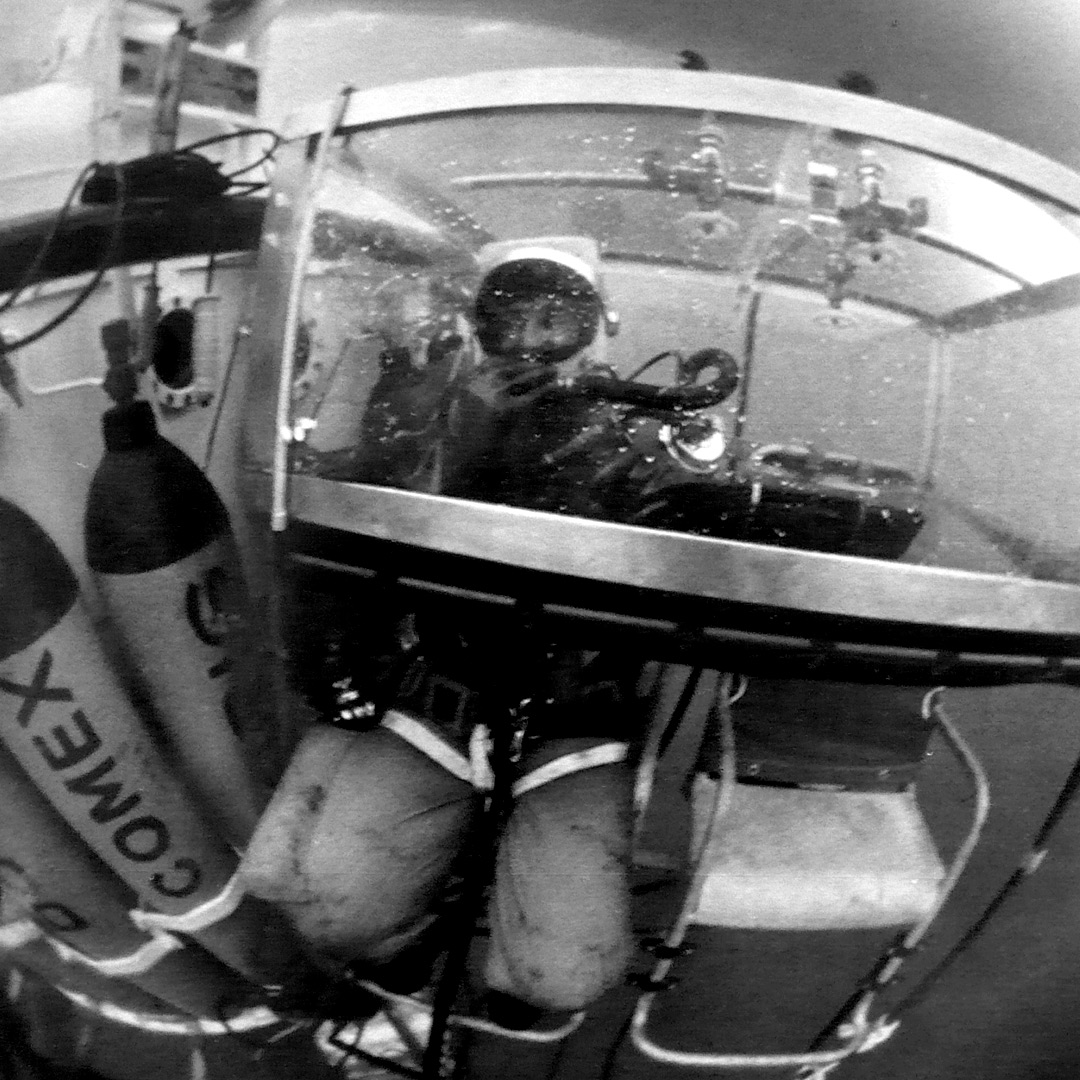
The Hydra experimental deep dive series led to two world records that are still standing today. The offshore record was established during Hydra 8 in March 1988 when two Comex divers did actual work at a depth of 1752 ft/534 m.
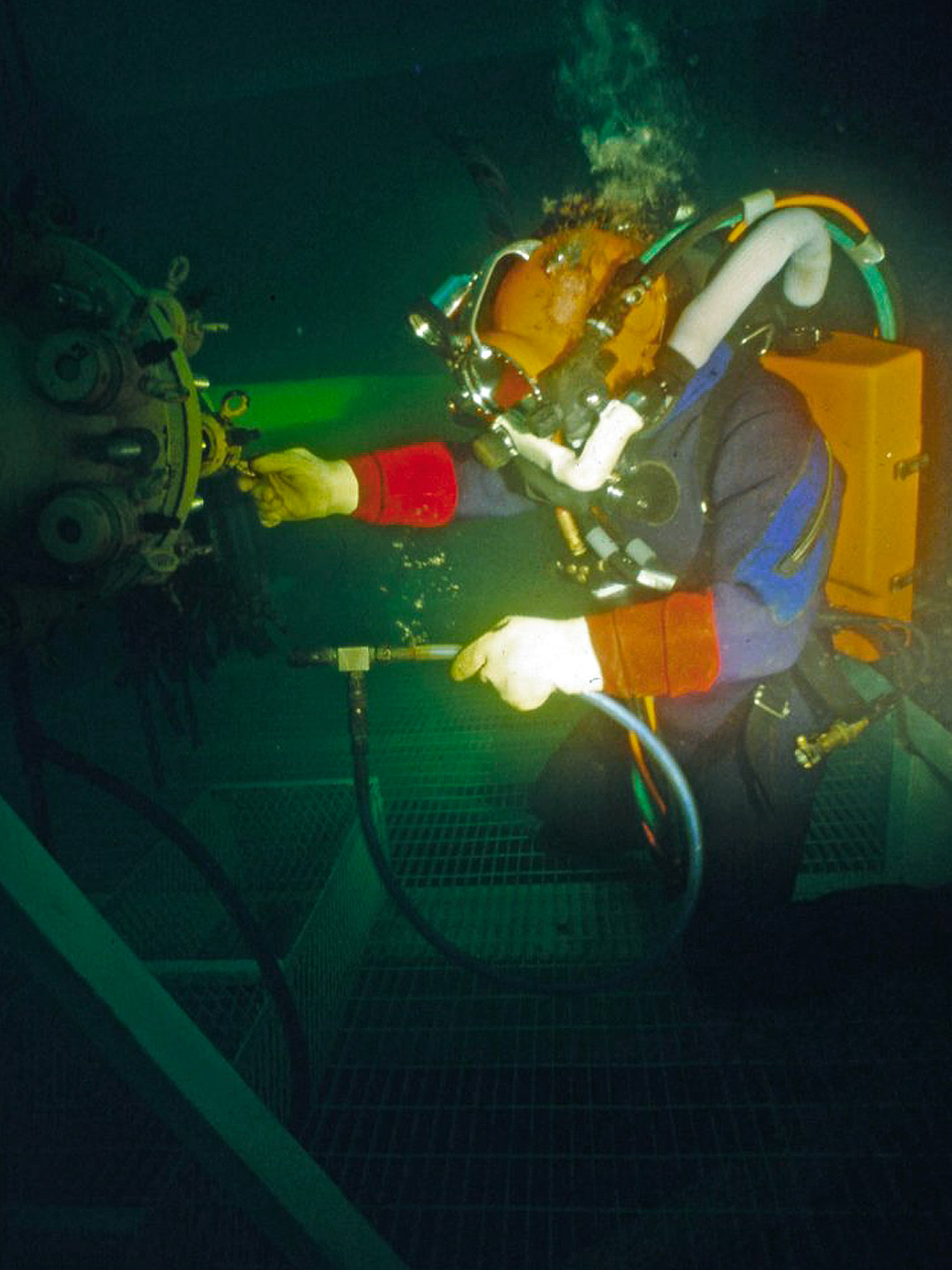
The onshore record was achieved during Hydra 10 with a simulated hyperbaric dive to 2,300 ft/701 m established in 1992.
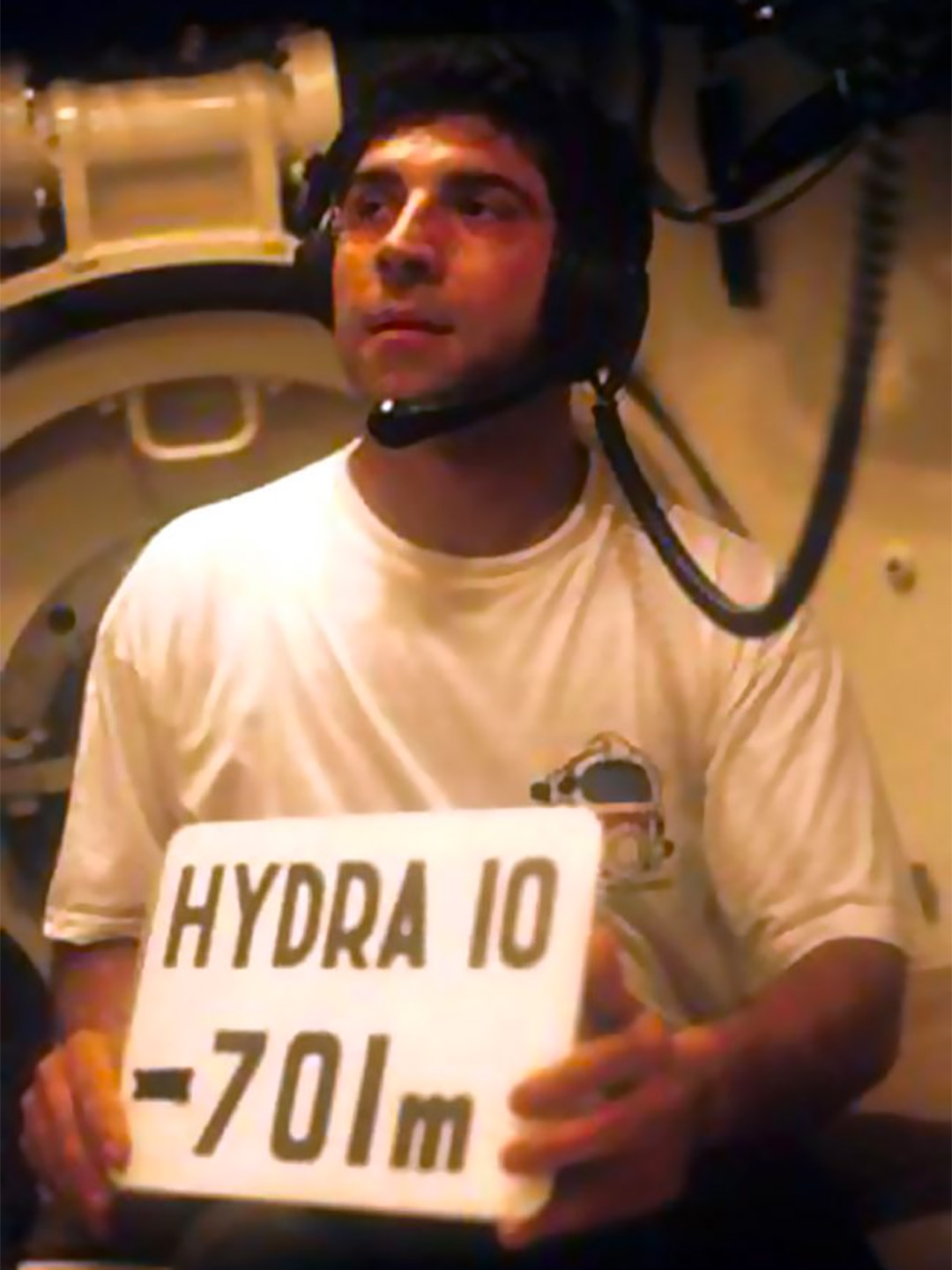
Both world records became only possible thanks to Dr. Brauer’s groundbreaking research. If Dr. George F. Bond was the father of saturation diving, Dr. Brauer was the guy who brought it to a whole new level.
Brauer’s Single Red Sea-Dweller Under The Loupe
Brauer’s watch has several unique features which suggest it was the very first Sea-Dweller to feature a valve. First there is of course the unique case number 1820177. The question that arises is why did Rolex not simply send Brauer a 1.7 million Sea-Dweller? Why make a special watch? The only plausible answer is the 1.7 million Sea-Dwellers were initially not made to feature a valve. Instead of trying to retrofit the valve into an existing case, Rolex designed Brauer’s watch case from scatch with enough space to incorporate the valve perfectly.
There are at least three known 1.6 million SRSDs with Gas Escape Valve. The way the valve is installed compared to Brauer’s watch and the fact these watches were distributed among SEALAB 3 participants in October 1968 – several months after Brauer got his – suggests the valves were retrofitted in a Rolex USA service center. 1.6 mil SRSDs without valve were given to Deepstar 4000 submersible pilots in November 1968 and to Tektite 1 Aquanauts in February 1969.
Oyster Case Shape
A closer look at the case shape of Brauer’s watch reveals significant differences compared to 1.6 million SRSDs and 1.7 million DRSDs respectively. This becomes particularly apparent in the profile view. To better accommodate the valve, the case of Brauer’s watch (bottom) is slightly thicker in the center, giving the lugs a more streamlined appearance.
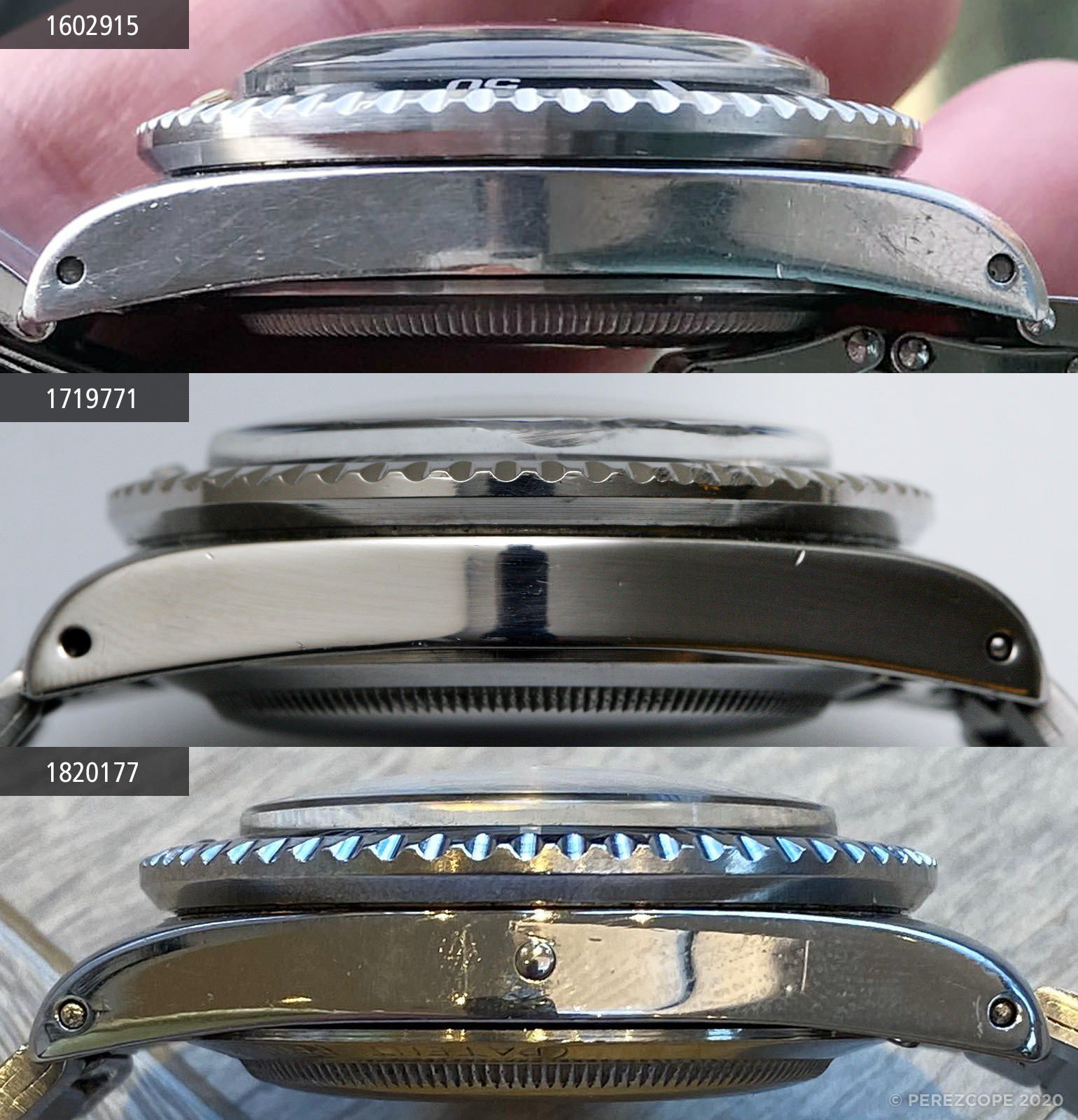
Being a prototype in the truest sense of the word, Brauer’s watch was made with special care. Unlike later serial production pieces, every detail on Brauer’s watch is super precise.
Valve Installation
To fully grasp the importance of Brauer’s watch it is essential to dive deep into it and explore the way the valve was installed on the inside of the case. The first generation Gas Escape Valve of Ref. 1665 was quite rudimentary and consisted of only three parts. The valve stem (1), a rubber gasket (2) and a flat spring made of spring steel (3).
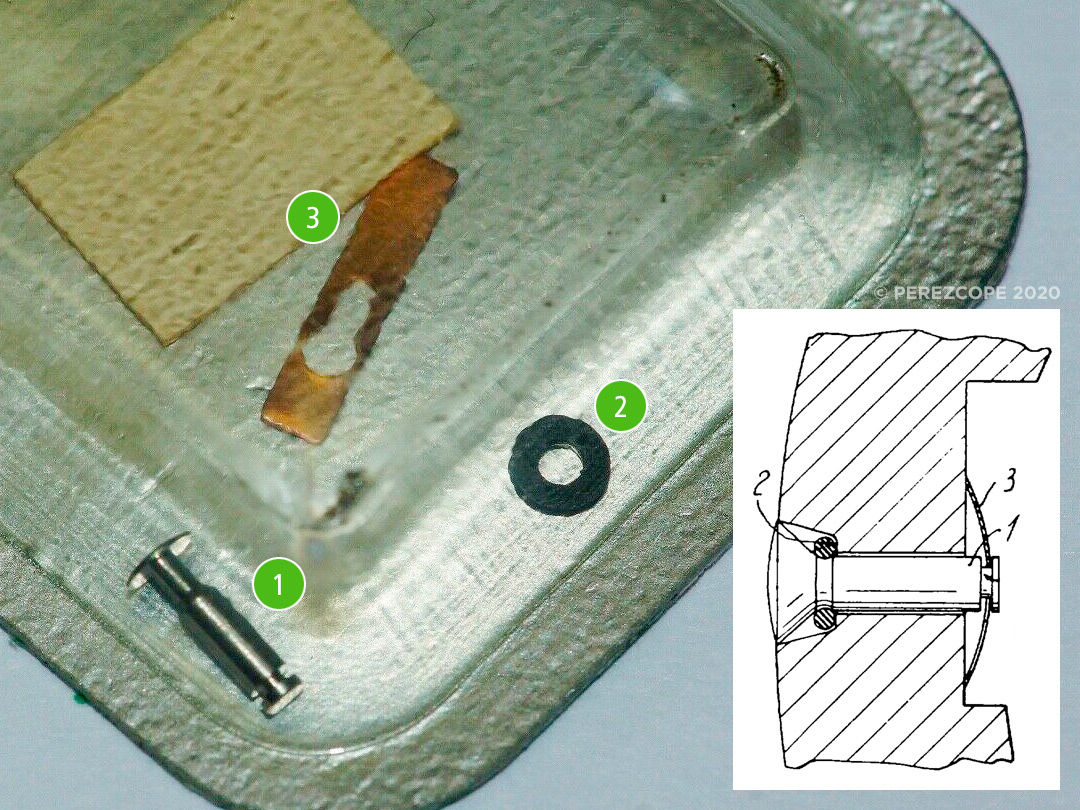
Here is how the Gas Escape Valve works. The valve stem (1) is kept in place by the flat spring (3). When a certain inside pressure is reached due to accumulation of helium, the trapped gas pushes the valve stem outwards against the resistance of the flat spring in order to escape in a controlled fashion. Water cannot enter the case as external pressure keeps the valve stem pushed against the rubber gasket, hence creating a impenetrable seal. Decompression takes place in dry hyperbaric chambers.
The next picture shows the perfectly fitted valve inside Brauer’s watch. Interestingly, not all valves in Ref. 1665 are fitted with the same accuracy.

The following comparison shows Brauer’s prototype vs. one of the SRSDs from the 1.6 million batch that features a valve. Brauer’s watch has a precisely machined seat for the flat spring. On the 1.6 mil SRSD, the valve looks like an after thought. It was installed in a rather improvised fashion in a case that in my opinion was never meant to have a valve.
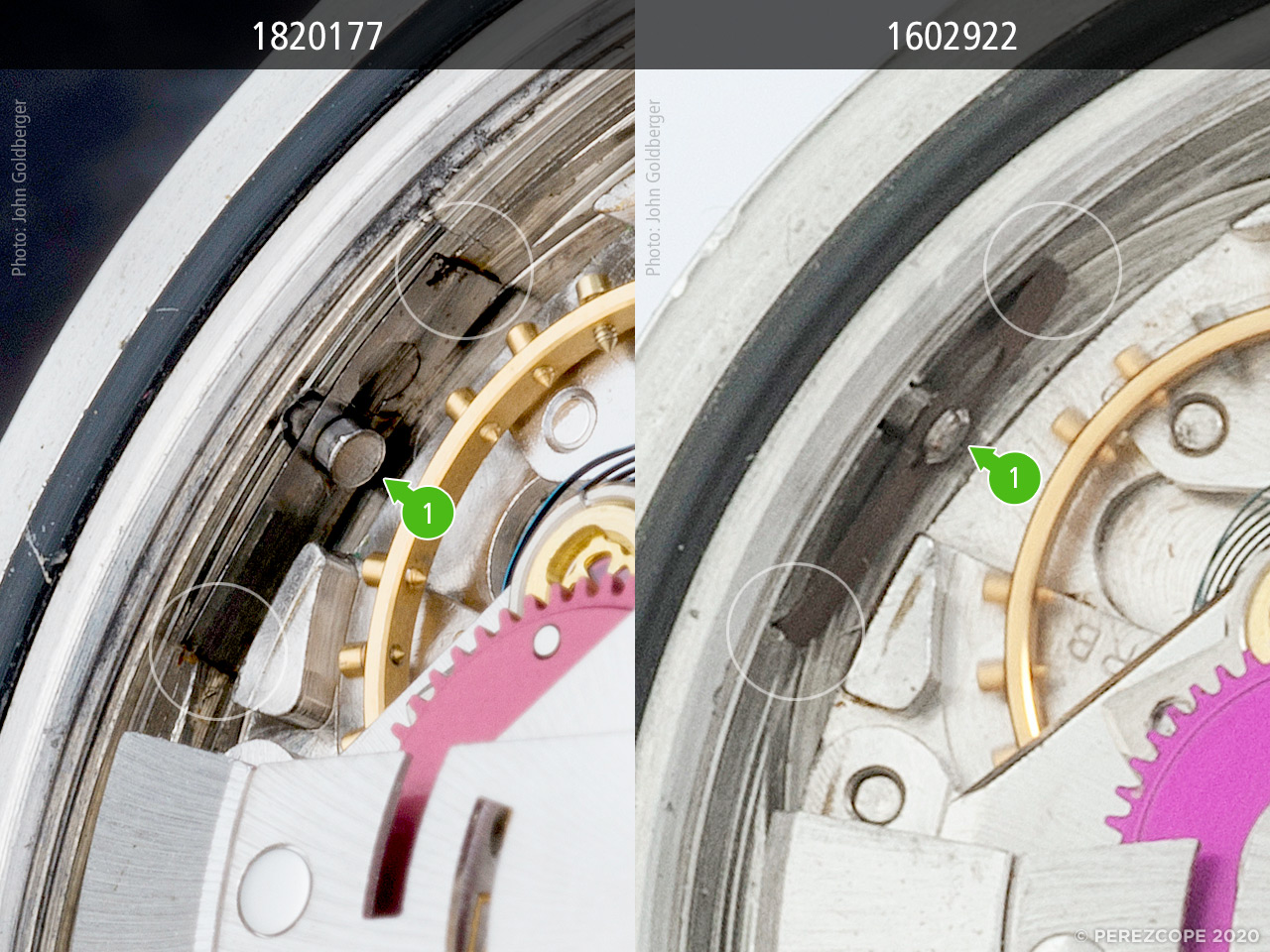
On the inside of the 1.6 mil SRSD there is notably less space than in Brauer’s watch and accordingly, the flat spring has a reduced width. This is absolutely consistent with the prior observation that Brauer’s watch case is slightly thicker in the center.
The valve stem itself (1) is notably different in shape. On Brauer’s watch, the stem looks like an precisely machined part. The same bit looks rather raw and imprecise on the 1.6 mil SRSD.
A comparison of Brauer’s watch with a later prototype from the 2.1 million batch shows the valve is fitted in almost identical fashion. The valve stem on the later watch has a bevelled edge. Interestingly, the valve stem found in the 1.6 mil Single Red Sea-Dweller shown above looks closer to this than to Brauer’s.

A closer look at the above comparison reveals also that the 2.1 mil case is slightly thicker compared to Brauer’s watch (see frame). A profile comparison confirms this observation, in addition to show the obvious differences in shape. The lugs on Brauer’s watch appear more streamlined.
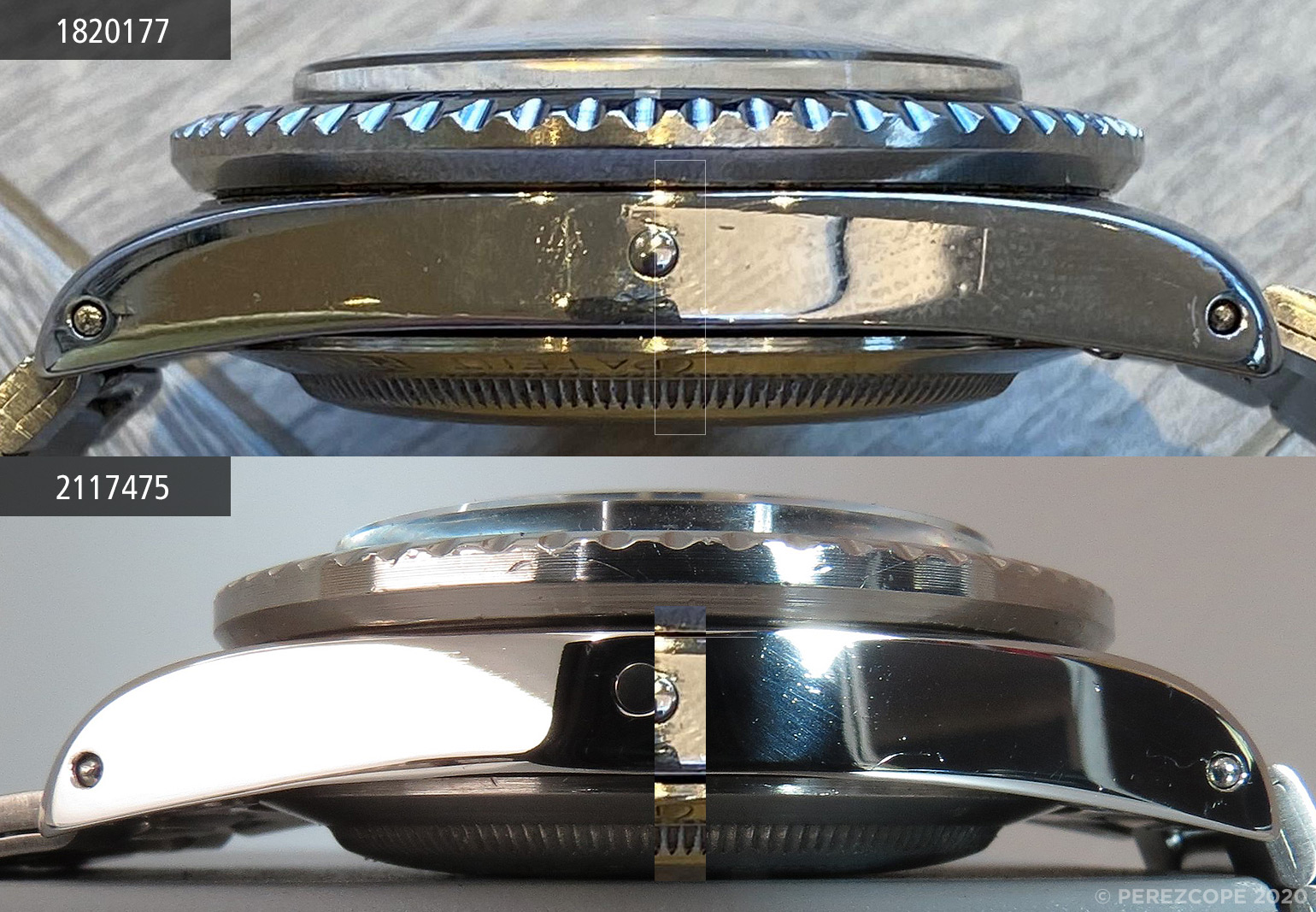
Another thing interesting to note is the difference between early Sea-Dweller bezels and those of later batches. The knurling at the edge is notably deeper in early bezels.
A comparison between Brauer’s watch and a Double Red Mk2 Sea-Dweller from one of the 1.7 mil batches shows how little space there is inside the latter. The width of valve spring is considerably smaller, almost identical to the retrofitted 1.6 mil valve.
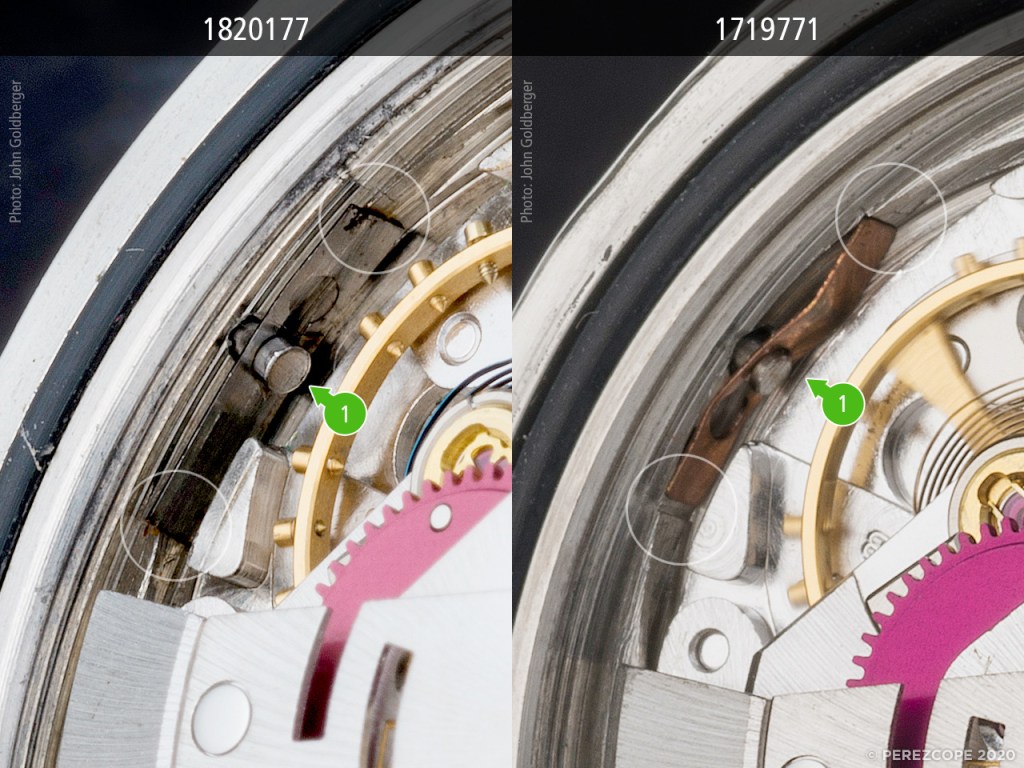
The discrepancies between Brauer’s watch and the earliest 1.6 mil SRSDs with valve are in my opinion a clear indication that the valves on 1.6 mil SRSDs and 1.7 mil DRSDs were retrofitted. More on this in part two of The Sea-Dweller Chronicles.
Patent Pending Caseback
Another interesting detail that supports the Rolex service center theory is the way the Oyster Gas Escape Valve (Patent Pending) inscription was applied. This designation became necessary since the patent was still under review in 1968. At the time of the filing, the Swiss Patent Office was overwelmed with thousands of patent applications which ultimatelly led to enormous delays. A process that would normally take one year, required more than two and a half years.
The picture below compares Brauer’s watch (top) to the other two known examples. The first thing to note is that on all three casebacks the typeface looks like handwriting. A closer look reveals the typeface on Brauer’s watch is slightly different than on the two other examples which appear to be almost identical.
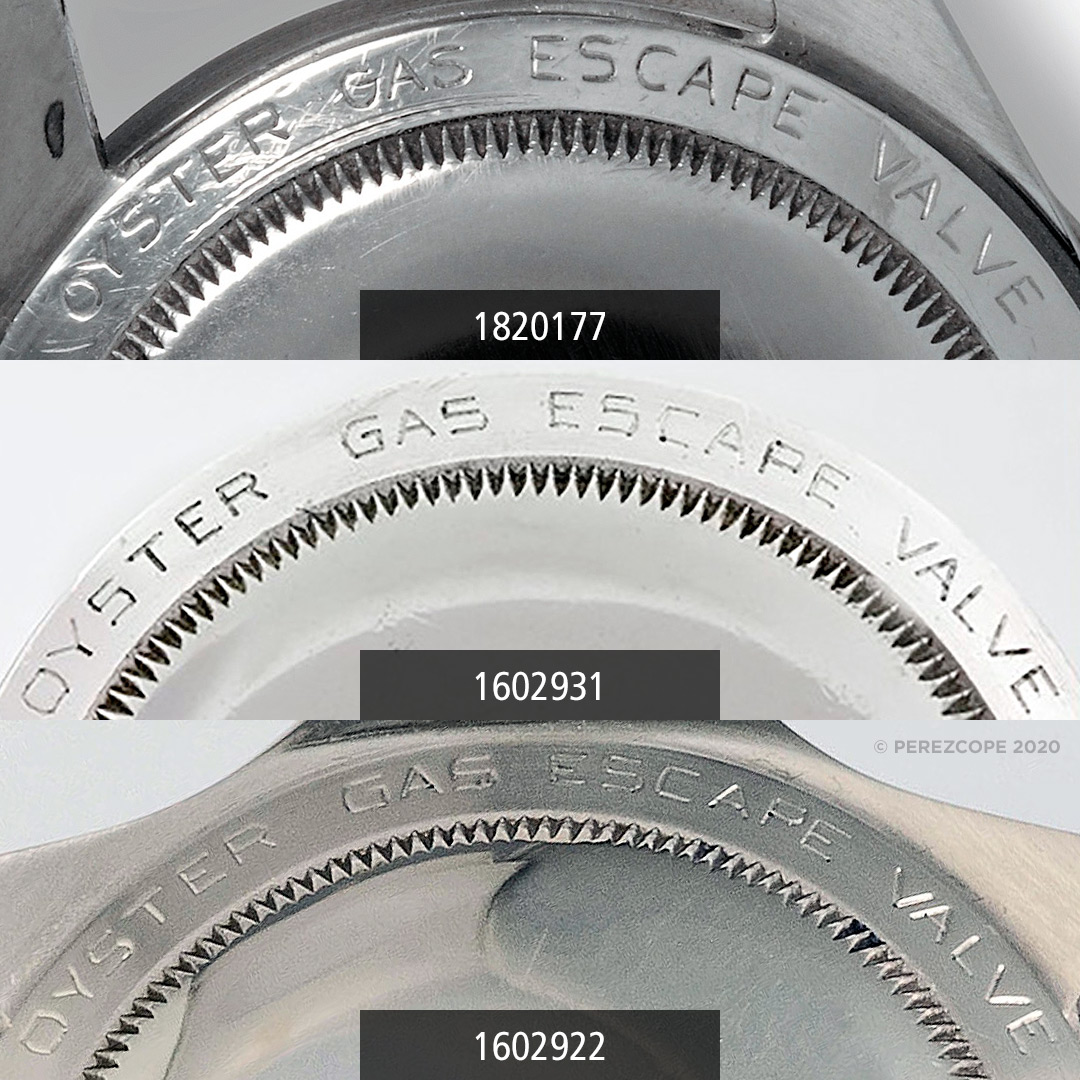
The Patent Pending designation offers a similar picture. In addition, the letter-spacing between VA of Valve and PA of Patent is inconsistent in the two other examples. Those letters are too close to each other. The insciption on Brauer’s watch appears to have been made by someone with a better sense for typography.

The letters on Brauer’s caseback appear to be punched rather than engraved. See the material displacement around to the letters on the picture below? This effect occurs only as a result of punching/stamping.
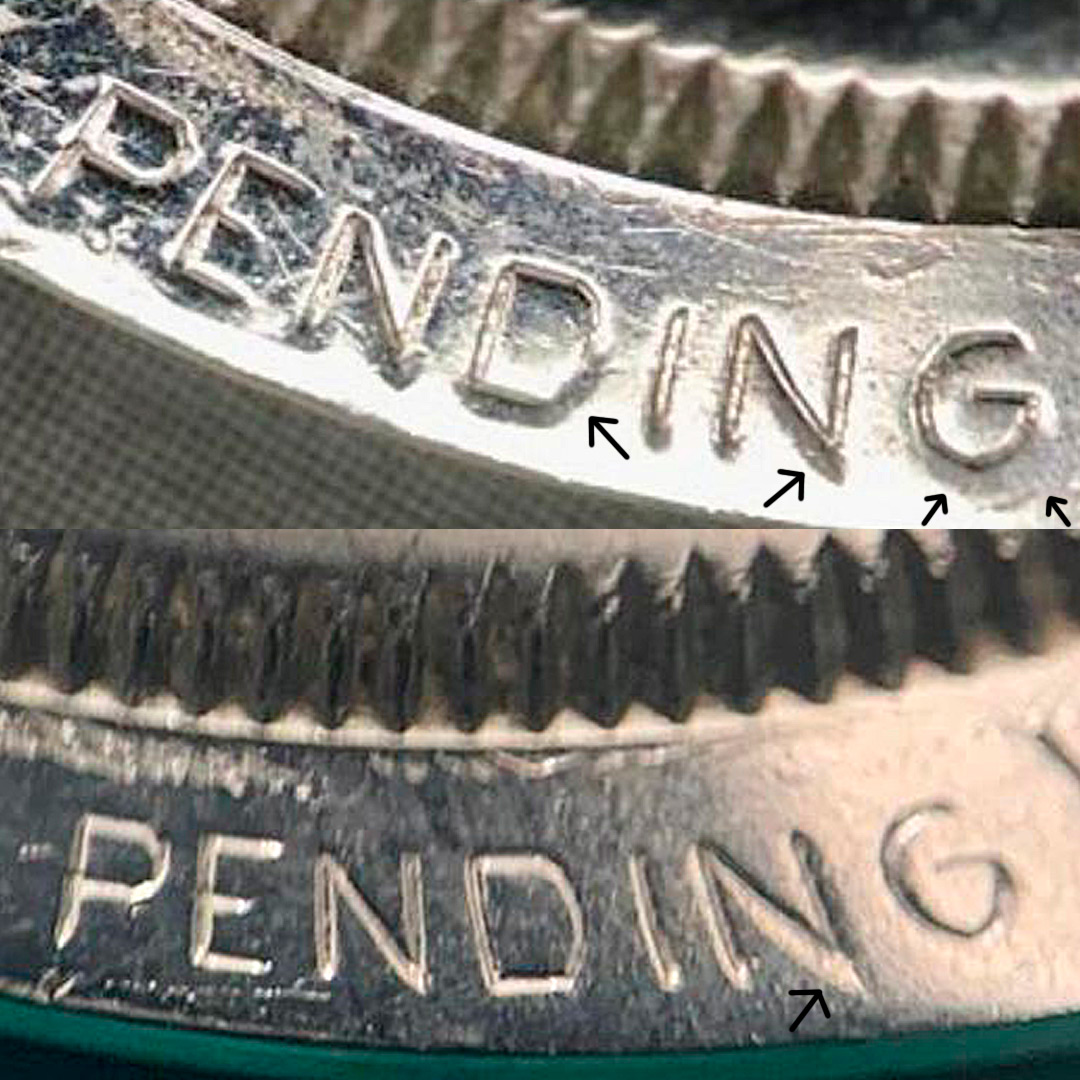
A closer look at the curves shows they were made with straight lines. This was clearly not engraved.
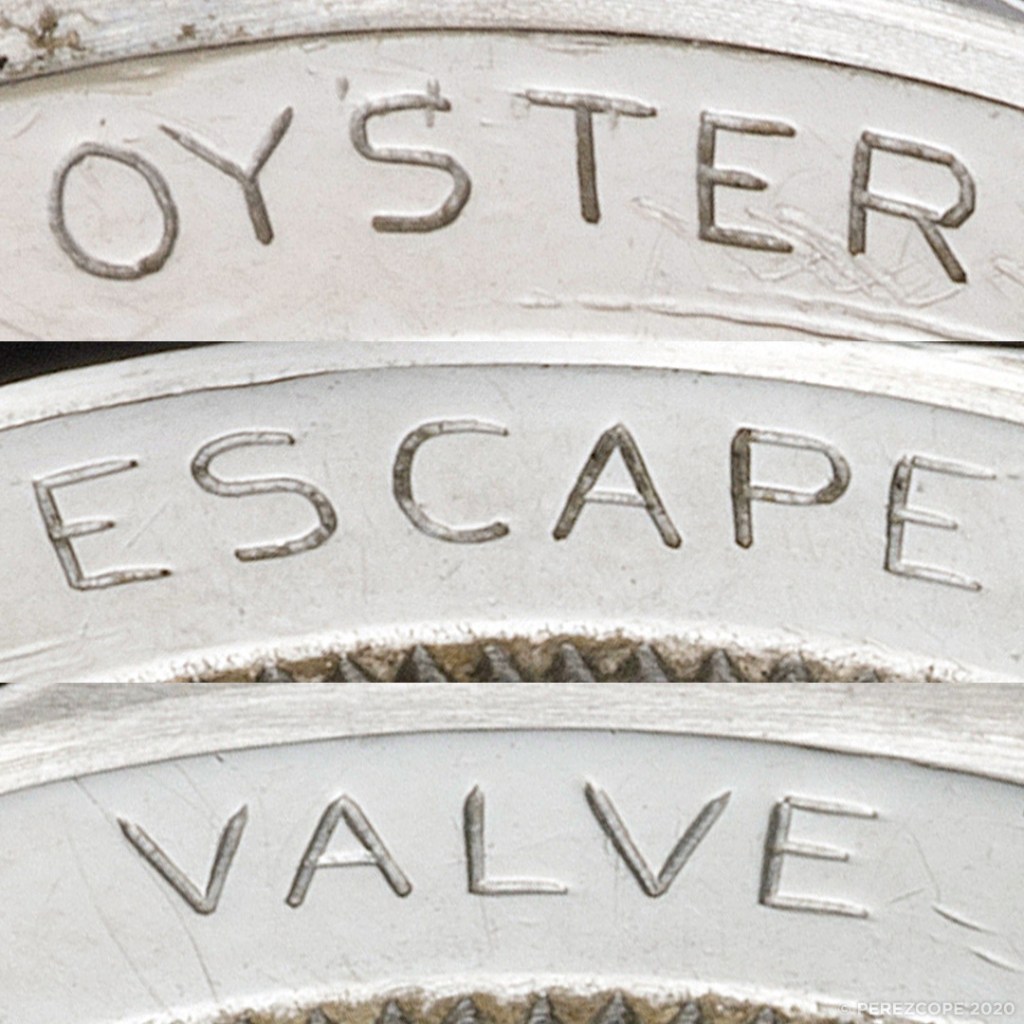
Applying the inscription in this way must have been a Sisyphean task, meaning it took very long to get it done. This was probably the reason why the other watches were engraved which in turn is just another indication that Brauer’s watch was the very first to feature this designation.
Late 2000 – Brauer’s Prototype Enters the Collectors Market
As mentioned earlier, after inheriting all of Dr. Ralph W. Brauer’s belongings, the University of North Carolina Wilmington sold some of his more wordly items while keeping thousands of papers and art items like for instance the Japanese wood-cut engraving below.

Explore: Dr. Ralph Brauer Collection – Randall Library UNCW
This is how Brauer’s important piece of horological history entered the watch collectors market in late 2000. The watch was acquired by a collector duo that used to work together back in the days. One of them was none other than the famous Paneristi named Hammer aka Alan Bloore. Unfortunately, Hammer never got the chance to see the watch in the flesh as his business partner – who bought the watch from the university – posted the Single Red Sea-Dweller on an old Rolex collector forum and quickly received an offer which Hammer could not match at the time in order to become the sole owner of the watch. Hammer, sensing the importance of this watch, had to let it go and regrets this to this day as the following forum post from April 2012 states.
Read more: My WORST sellers remorse, what was yours ? Still can’t believe it (vintagerolexforum.com)
There is another interesting angle to this watch worth mentioning. After Hammer’s business partner sold the watch, delivery and pick-up took place on September 11, 2001 in New York. Basically, this very watch was at the epicenter of an event that sent shock waves around the world.
The following timeline is a summary of the above written. It shows Brauer’s watch in its historical context. Please click the graphic to zoom in.
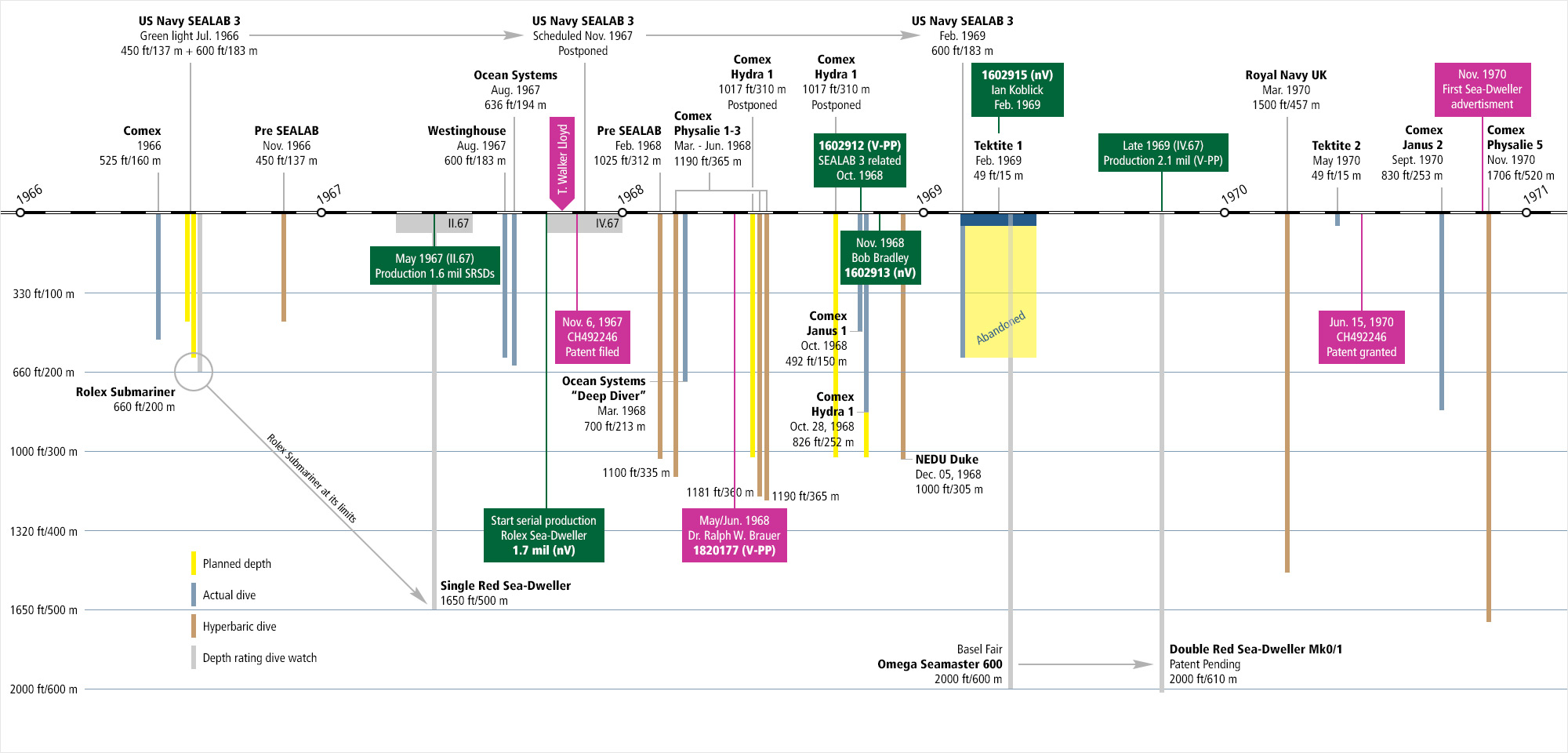
Brauer’s Single Red Sea-Dweller was published in all details in the book A Journey Into The Deep by John Goldberger. The volume offers an amazing overview of incredibly rare Rolex dive watches. Many of the pictures published in this article were provided by Mr. Goldberger.
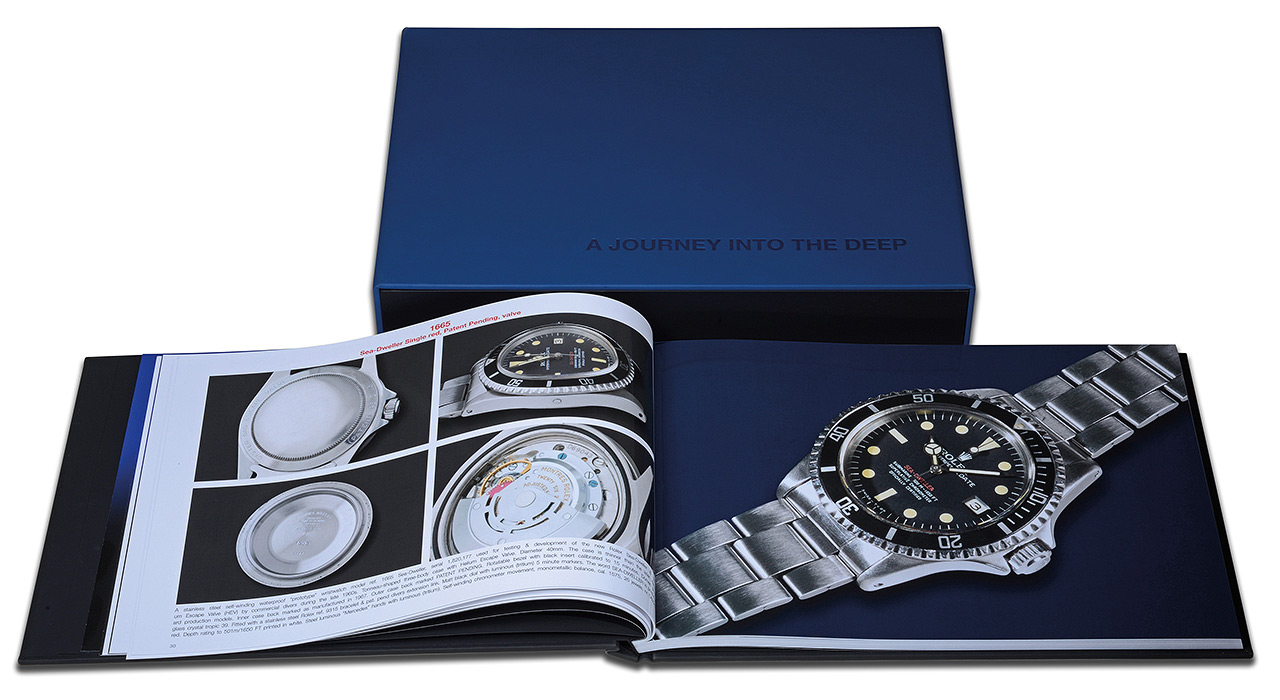
Buy Online: A Journey Into The Deep (Hodinkee Shop)
Thoughts
Brauer’s watch was one of the first Rolex Single Red Sea-Dwellers recorded in my database. I remember how confused I was about the unique case number. I was aware of the water tight provenance but the case number made little sense to me. After four months of extensive research, I came to realize the importance of this piece and believe the truth about this amazing piece of history has finally come to the surface. The Genesis of the Rolex Sea-Dweller was always there, hiding in plain sight.
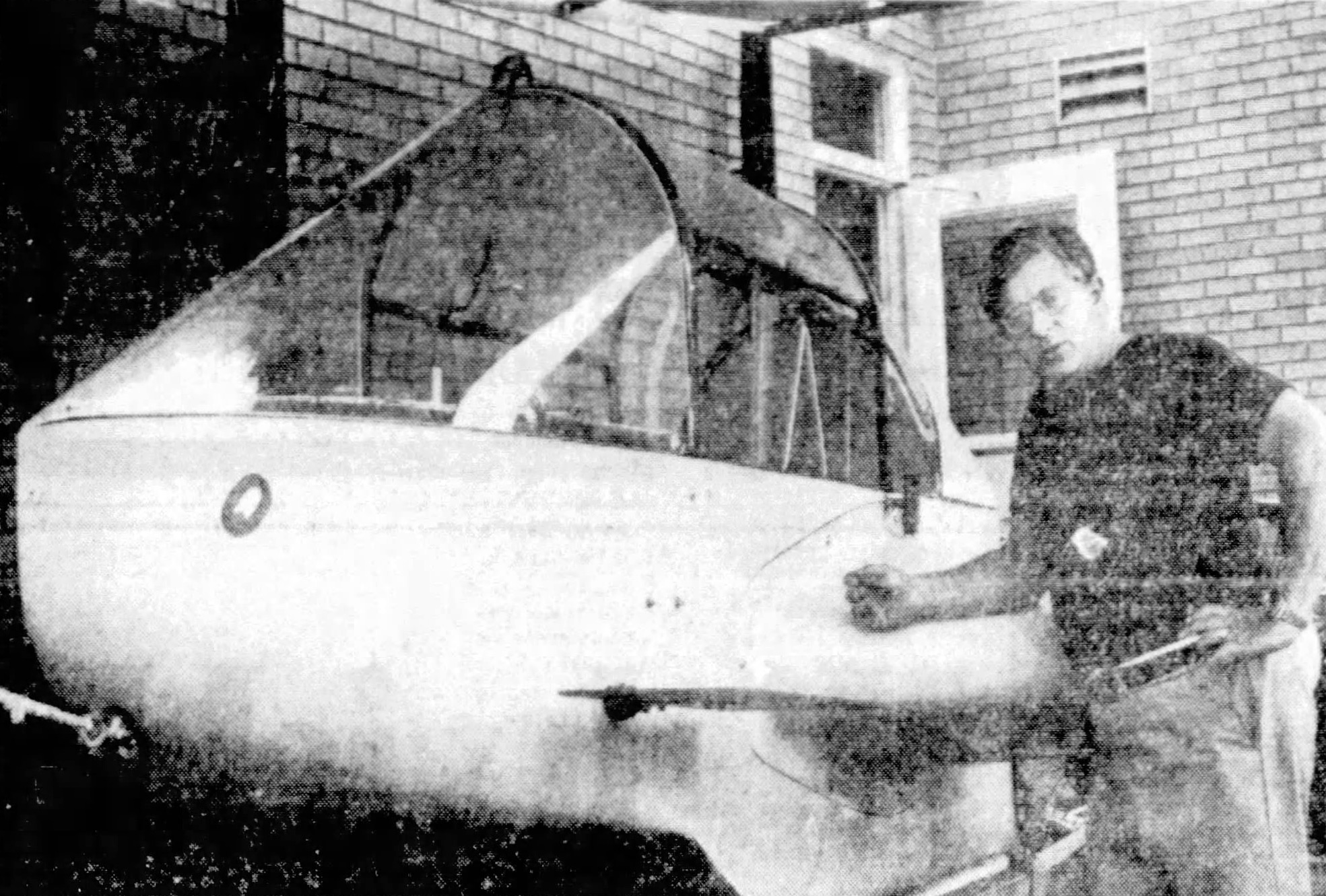
The above picture shows Dr. Brauer next to a 20-foot mini-submarine acquired by the Wrightsville Marine Biomedical Laboratory for their research. On his wrist, his unique Single Red Sea-Dweller.
The second part of The Sea-Dweller Chronicles which will cover the time between 1969 and 1971 will be published soon. Thank you for your interest.
Special thanks to: Tom Bolt (@watchguru_), John Goldberger (@goldberger), Jake Ehrlich (@rolex.magazine), Petros Protopapas & Omega Museum (@omegamuseum), Silas Leung (@silas815), Nicholas Biebuyck (@nicholasbiebuyck), Valdo (@119_code_commando), Philipp Stahl (@rolexpassionreport), Luc Broussaud (@comex3133), Bob Roer, Marc Wright, Eddy Stuart, Peter B. Bennett & Ian Koblick.
.
History of the Rolex Sea-Dweller
The development of the Rolex Sea-Dweller goes hand in hand with man’s persistence to push the boundries and reach never before thought possible depths. The following infographic shows the evolution of the Sea-Dweller in its historical context.
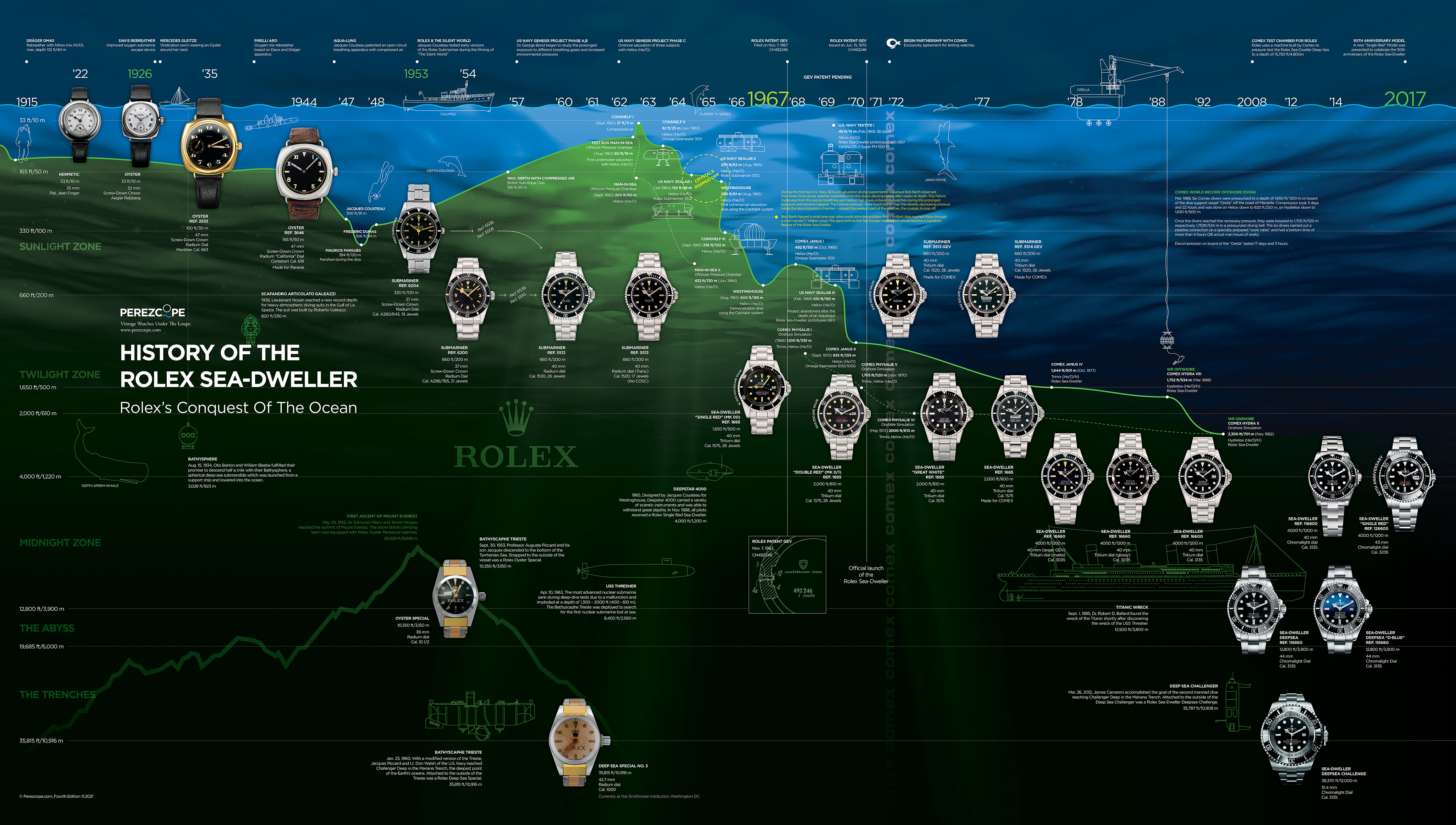
This graphic is available as a high quality print in two sizes:
- Regular small, 120cm x 68cm (47 x 26 inch): EUR 85.00 (plus shipping)
- Regular, 150cm x 85cm (59 x 33 inch): EUR 120.00 (plus shipping)
Limited: 50 pieces, numbered and signed by Bob Barth, the legendary US Navy Aquanaut who pioneered saturation diving during the famous SEALAB missions. Bob developed the idea for the Rolex Gas Escape Valve: Sold out

Another fantastic article, an interesting note a mini-sub identical to the one in the picture can be seen on display in Key Largo. I had a chance to see it up close before spending some time on Aquarius.
LikeLike
Exceptional and informative work–as always. Thanks you!
LikeLike
Hi Jose, I’d like to send an email to you, but I didn’t find an address. Can you reply to mine? (I think you’d see it because it’s necessary for replying here). Thanks in advance, Vittorio 🙂
LikeLike
Please check your email (also spam folder)
LikeLike
Amazing article. I had the honor of working under doctor brauer as an undergrad at the institute. Brilliant man, mentor, researcher.
LikeLike
Long read but super informative and interesting!
LikeLike
Thank you so much for this article. Again a great work of research and writing! Enjoyed reading it very much
LikeLike